 By Staff By Staff
August 13th, 2019
BURLINGTON, ON
One of the beauties of an on line newspaper is the opportunity to look at the back and forth in communication between two people.
In what follows we give you a look at how David Barker’s electronic conversation with Burlington MPP Jane McKenna went.
 Barker, a Lakeshore Road resident, takes issue with Jane McKenna’s position on affordable housing. She basically sticks as close as possible to the Ford government position- something Jane has always done. She knew the lines to the Tim Hudak position on significant issues better than Tim Hudak did when he was PC party leader. Barker, a Lakeshore Road resident, takes issue with Jane McKenna’s position on affordable housing. She basically sticks as close as possible to the Ford government position- something Jane has always done. She knew the lines to the Tim Hudak position on significant issues better than Tim Hudak did when he was PC party leader.
Have a listen to how McKenna digs a hole and then looks for ways to dig down even deeper.
David Barker to Jane McKenna June 22nd, 2019
On Sat., Jun. 22, 2019, 11:25 a.m. Barker wrote:
Ms McKenna in your statement directed towards the We Love Burlington group, published in the Burlington Gazette, you state “Our estimates from the Ministry of the Attorney General show that over 100,000 housing units are caught up in legacy cases at the tribunal. That’s 100,000 desperately needed homes that can’t get built – or three years worth of construction in Ontario waiting for approval….” By making this statement, Ms McKenna, you imply that you would expect all 100,000 units that await review by LPAT would gain its approval.
Maybe you did not mean to imply that. But your statement reflects exactly the public’s perception of just what is wrong with LPAT (and before it OMB). The perception is that the unelected, unrepresentative body seems to invariably side with the developer’s position, completely ignoring the municipality’s official plan and the desires of the local residents.
Please can you provide any justification as to why the Province of Ontario should even have an unelected, unrepresentative body to pass judgement on how a municipality manages its development. As far as I am aware no other Canadian Province has such a body. I assume in those other Provinces the developer’s recourse is to a non-political court system. Should that not also be the recourse here in Ontario?
Surely if a municipality has an official plan that has been accepted and approved by its region (and by implication the Province) why should that municipality then be second guessed by an unelected, unrepresentative political body. If a developer’s proposal does not comply with the requirements of the municipality’s (Region/ Province approved) official plan, then surely the developer should not expect municipal plan approval until it does conform.
My understanding is the official plan in effect in Burlington dates back to 2008. That means the official plan has been in effect for ten years NOT twenty five years as you contend. That 2008 official plan, although soon to be superceded by an updated official plan, does in fact remain compliant with regional and Provincial requirements. As such it should be respected by all, including developers, the Province and LPAT.
Ms McKenna you are right to champion the need to increase the supply of affordable housing, both rental and owned. I believe you will find allies for that goal at the Region, at Burlington City Council and in the community. However, the high rise condo developments proposed for downtown Burlington do not in any meaningful way address affordable housing. The price point of the proposed condos are way outside the affordability of first time home buyers. Further the monthly rental cost of those units being bought by investors for the rental market is also likely to be well beyond the budgets of the twenty somethings who look for affordable rental accommodation. So for you, Ms McKenna, to in any way imply that the developers proposals for downtown Burlington high rises address affordable housing is completely disingenuous on your part.
Please, Ms McKenna would you temper your standing up and defending the bullying Ford government, of which you are a part, with more standing up and advocating for the desires and positions of your constituents who elected you to represent them. Those views are clearly and accurately expressed and advocated by the City of Burlington Council.
I dare you to publish on your website this opposing view to your statement. But I doubt you are either brave enough or confident enough to do that.
Barker to McKenna June 30th.
I’m looking forward to your response to my emailed message below.
McKenna to Barker August 7th.
Mr. Barker,
Every community in Ontario is unique. But no matter where you go, one thing is the same – people are looking for housing that meets their needs and their budget.
Here in Burlington, the cost of buying a home is becoming out of reach for many and affordable rentals are too hard to find. In addition, the high cost of housing is making it harder to attract investment and create jobs.
According to 2017 projections by Ontario’s Ministry of Finance, Halton Region will grow by 56.2 percent over the next 22 years – making Halton the fastest-growing area in the GTHA. That’s why we need to get the housing supply right – the right housing, in the right place, at the right time in the most efficient way.
Provincial growth plans have determined land use patterns for over a century. Regional and Municipal Official Plans align to provincial policy and are used in planning local communities.
Ontario is not the only province that handles appeals involving municipal planning decisions with a Tribunal. Like Ontario, Alberta is also home to some of the fastest growing cities in Canada; they also handle municipal planning with a tribunal.
The tribunal exists because people don’t always agree on how their communities should develop or change. Disputes often arise over land use planning issues, such as where industry is located, where roads and transit are built, protecting environmentally sensitive lands and managing overall development. When people are unable to resolve their differences on planning issues or have disputes with their municipal council, the LPAT provides a forum to resolve those disputes.
Recently, Halton Regional Council passed a motion calling on the government to eliminate the LPAT. Unfortunately, this is not an option as it would remove the ability for residents to appeal Council decisions outside the courts. Relying on our over-burdened court system would increase costs, delay decision making and hinder people’s ability to settle planning disputes.
Our government’s recent decision to appoint 11 new adjudicators to the LPAT will speed-up decision making to address the 2 to 3-year backlog of appeals.
As Burlington works to create a new Official Plan, our Mayor and Council continue to receive expert advice from local and provincial planning staff. That’s why I’m confident that by mid-2020, under a new Official Plan, the number of appeals will be reduced, with the LPAT playing an important role in ensuring critical checks and balances are in place.
Best regards,
Jane
Barker gets back to McKenna before the end of the day on August 7th.
Thank you for your email below. Its contents do raise further questions in my mind, which you might be able to answer or comment upon.
I totally agree with you that so much more needs to be done to provide the “affordable” housing that is needed for the less well off in our society. The main hurdle to achieving that goal is that it does not make commercial or economic sense for developers to create affordable housing when ROI is so much better with condos and single family homes. Ontario should look to other jurisdictions outside of Canada where local, regional and central governments provide the affordable housing stocks. It is nonsense and folly to believe the private sector will step up. Doug Ford, the Premier for the People” surely would want to champion a Housing for the People initiative funded through the three levels of government.
I would hazard a guess that of the 100,000 units you have cited as being held up at OMB/LPAT less than 5% would relate to applications for affordable housing developments. Perhaps you have a supportable number for this?
Those applications for multi unit developments in Burlington tied up at OMB/LPAT, I am confident are all for $500,000+ condos or similar price point developments. Not for affordable housing.
Tying the affordable housing issue to the purpose or need for an OMB/LPAT body is not appropriate or valid.
You say, once Burlington, or any other municipality, gets its OP compliant with Provincial requirements the number of instances of appeals being accepted for adjudication by LPAT will be substantially reduced. That being the case why could a dedicated Property Planning Court not be created to deal with the appeals.
Surely it is better to have an independent judiciary act as the arbiter rather than an unelected body of political or patronage appointees, who likely have no connection to the municipality. If a separate Property Planning Court is a no go, then why not have a requirement that the LPAT tribunal members must be resident in the municipality from which the matter emanates.
You cite cost as being an insurmountable hurdle that rules out the use of the courts as a viable place to settle disputes. The cost to appeal a municipality’s decision to LPAT likely puts an appeal out of the financial wherewithal of individual residents. Lawyers, planning consultants and other expert type witnesses are required, all costing a pretty penny. Developers have deep pockets. Individuals do not. A “small claims court” type model for a Property Planning focused court should be the way to go.
You have cited Alberta as another province with an LPAT type system. So perhaps you can elaborate as to how other provinces deal with planning disagreements. What happens in say BC, Quebec, Nova Scotia. Can Ontario not learn anything from those provinces?
You mention Halton recently passed a resolution calling for the end of LPAT. The regional and city council’s were more recently elected to office than were MPPs. Your words come across like those of an overly protective or controlling mother telling her child “no, don’t bother your pretty little head with that, Mommy knows what’s best”.
Might I suggest in the next month or so you host a constituency meeting on this subject so that you can hear directly from your constituents on this subject.
David Barker
Jane gets back to Barker on August 12th
Mr. Barker,
Thank you for your follow up email including your suggestions.
Best regards,
Jane
Barker gets back to Jane – he is like a dog with a bone and he isn’t letting go.
Jane:
You are most welcome.
 Will you be offering your thoughts or comments as to those suggestions:- Will you be offering your thoughts or comments as to those suggestions:-
* a “small claims” model type court for municipal property planning disputes be set up to replace LPAT.
* an LPAT tribunal be comprised only of citizens resident in the municipality from which the matter emanates.
* you hold a townhall meeting within the next couple of months to have an open discussion on this matter, which is of immensely high interest to your constituents.
* have the Province and municipalities come together to finance, construct, hold and manage a stock of affordable housing.
I look forward to hearing from you.
David Barker
Blair Smith, a citizen’s advocate adds his two cents:
If the Government really wanted to increase affordable housing then it would act as responsible governments do – as stewards of the public trust – and mandate that developers do much, much more to provide housing that applies. If you leave it to the private sector with incentive programs and self-regulating regimens then your last name may be Wynn. Government is intended to fill the gap where private sector and self-interest will not go. Not a difficult concept.

 By Staff By Staff
August 13th, 2019
BURLINGTON, ON
Our friends across the Bay in Hamilton have published a newsletter that has to be shared.
Citizens at City Hall (CATCH) comment on Bill 108 and the degree to which it is going to gut the way planners within municipalities have to deal with development applications.
CATCH said:
Additional though still incomplete information has come from the province about massive changes being made to rules on planning, community benefit agreements, parkland funding and development charges. Described as “welfare for developers”, the More Homes, More Choice Act appears to mean more subsidies from property taxpayers and an abandonment of the claim that growth pays for itself.
 The good citizens of Hamilton have looked at Bill 108 -and they don’t like what they see. The view will be the same from this side of the Bay. The stated objective of the legislation is to lower housing costs. It eliminates growth fees for services such as libraries, recreational facilities, parkland development and social housing. These make up about a quarter of the development charges currently collected in Hamilton from developers to offset some of the costs of new growth.
Some of these revenue losses could be recovered with modified Community Benefits Charges that are included in the legislation. These replace existing “section 37” collections whereby cities bargain with developers who want to exceed approved building sizes and densities and in return obtain various community benefits.
But the modified community benefits charge will be capped by the province at a rate that has still not been released so there is no certainty that the financial result will be equivalent to that obtained by the existing two growth funding mechanisms. And if a city utilizes this community benefits charge it will be forced to abandon collection of parkland dedication fees – a long-standing method of ensuring sufficient land for parks.
Currently the parkland dedication fee – which has been in effect since the early 1970s – requires developers to provide land or monies based on the number of new residents in the growth area. Now it will be set irrespective of how dense the development.
Toronto staff have calculated that for one new apartment tower the new rules will mean an 80 percent drop in parkland paid by the developer. In another situation, the park area falls from nearly four square metres per resident down to half a square metre.
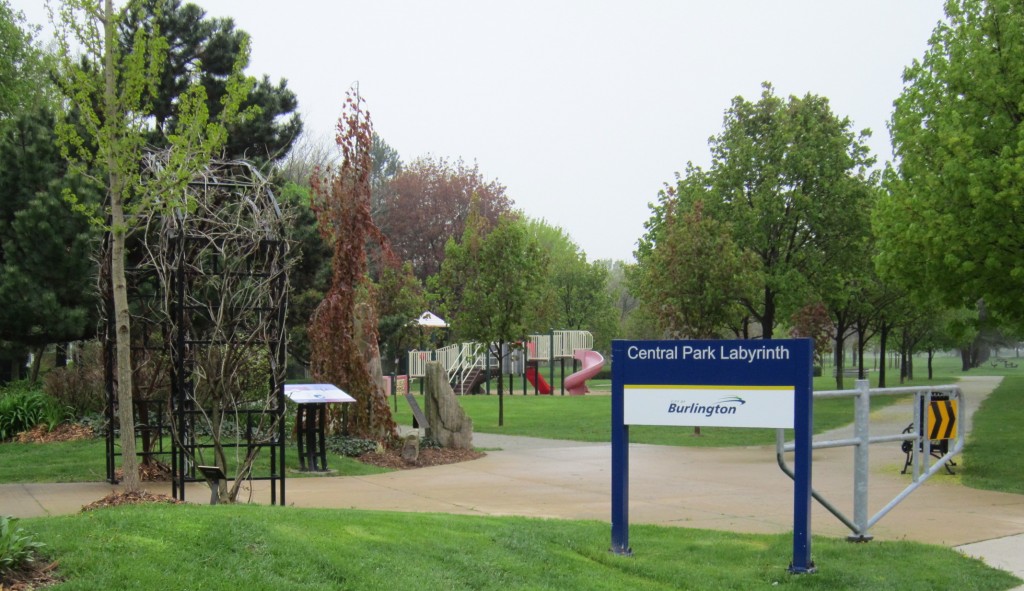 Developers will finance the same amount of parkland for a 48-storey building as for a four-storey one. This flies in the face of both provincial and local commitments to encourage higher densities, especially along major transit lines like the LRT. Instead the municipality will be penalized for more concentrated residential development and the developers will finance the same amount of parkland for a 48-storey building as for a four-storey one.
Other changes in the legislation drastically shorten the time allocated to cities to respond to development proposals. For example, the timelines for an official plan amendment drop from 210 days to 120. Local planners contend these make proper review and public consultation virtually impossible and will mean many more appeals to the provincial planning tribunal.
All of these changes are likely to leave existing taxpayers shouldering more of the costs of growth. As Hamilton’s chief planner Steve Robichaud warned in June: “There’s a big shift in terms of who pays for growth and how that balances and they’ve taken the costs off the developer and they’re shifting some of those costs onto the municipality.”
While the new rules are purported to lower housing costs, they don’t include any way to ensure this. “It is unlikely that they will positively impact housing affordability,” argue Toronto planners, “as Bill 108 does not provide for any mechanisms to ensure that reduced development costs are passed through to future home buyers and renters.”
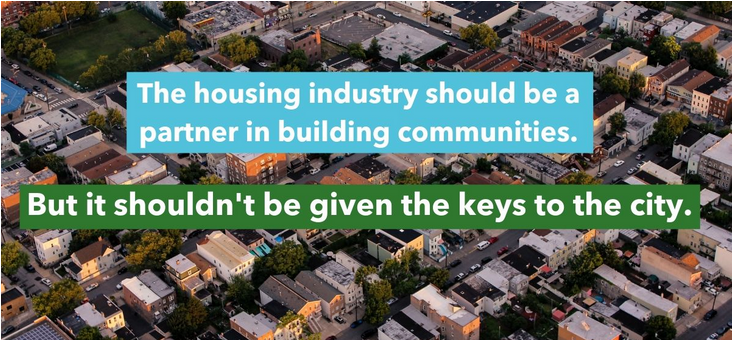 The developers may have been given even more than the keys to the city. The Ford government rushed through the legislation without details between May 1 and June 6, leaving municipalities scrambling to even provide comments on changes that could not be properly evaluated. Now Queen’s Park has extended the confusion with incomplete draft regulations and schedules.
“The province has not posted an actual draft regulation, but rather has posted a notice of intent to issue a regulation”, notes Hamilton staff.
“The regulations … have been provided in general terms and the full impact of the proposal is not capable of being fully understood and assessed without the official language that will appear as written in the regulation.”

 By Pepper Parr By Pepper Parr
August 12th, 2019
BURLINGTON, ON
OPINION
Earlier today the Gazette published an article on some problems that were brought to the public’s attention by Blair Smith and Lynn Crosby.
The problems they discovered after an exhaustive analysis of the data that was submitted to the City Clerk by each candidate brought some very disturbing matters to the surface.
Small administrative errors and typos happen. But when significant amounts of data just don’t appear a full public understanding of who contributed what to whom is no longer possible.
What makes the democratic system we have the success it is – is that we all abide by the laws in place and everything is transparent.
If the numbers aren’t available transparency isn’t possible. And once those who set out to game the system become aware that they can hide where their campaign election money came from, just imagine what can happen.
In a series that will follow in the Gazette in the weeks ahead we list who got what from whom and do our best to identify known developer interests.
Does receiving campaign funds from a developer mean that a candidate has compromised themselves – no but – know that developers are in business and they use their money to enhance their business interests.
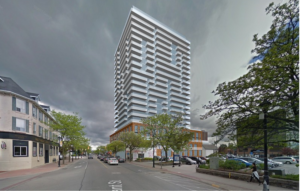 Two of the four buildings are done deals – two are working their way through the approval process. Did election campaign funding make them possible?  Done deal  Done deal  Looking for approval. The public depends upon the bureaucracy to protect their interests, to ensure that the data they get has been fully reviewed and meets the criteria.
How Mike Wallace got away with filing a return that did not have critical dates in his report is not just an oversight. It is sloppy administration done by people who don’t understand or appreciate that accuracy is important.
Are the results of the election in question? No.
The vote count was pretty decisive. The Office of Mayor was not won by money – it was won by a person who heard and responded to the cries of the people who pay attention to civic matters.
The disappointment is that less than 40% of the people who had the right to vote actually cast a ballot.
Mayor Meed Ward was not as unequivocal as she could have been on this matter; she has certainly had her issues with the way this Clerk has handled a number of matters in the past.
The comments made by the Clerk that this was a learning experience cannot be accepted. The position of Clerk in municipalities is significant; for example a bylaw is not in force until both the Mayor and the Clerk sign the document.
Smith and Crosby argue that the Clerk’s behaviour is “a completely unacceptable contravention of information practice and protocol, particularly for one entrusted with maintaining the integrity of the official record.”
It is up to Tim Commisso, City manager to decide what to do next, if anything. What he decides to do will say a lot about the kind of City Manager he is going to be.
There was a situation a number of years ago when the then Director of Planning, Bruce Krushelnicki, sitting at the Council table, advised council that a very senior member of his staff would no longer be in the employment of the city. He walked the individual back to his office; that was the last we saw of him.
Strong managers take strong action when it is necessary, providing they have just reasons for doing so.
Related news story:
Clerk revises public record – considered a no no.
Salt with Pepper is the musings, reflections and opinions of the publisher of the Burlington Gazette, an online newspaper that was formed in 2010 and is a member of the National Newsmedia Council.

 By Ray Rivers By Ray Rivers
August 8th, 2019
BURLINGTON, ON
OPINION
This is an election year and politicians show up at every chance they get.
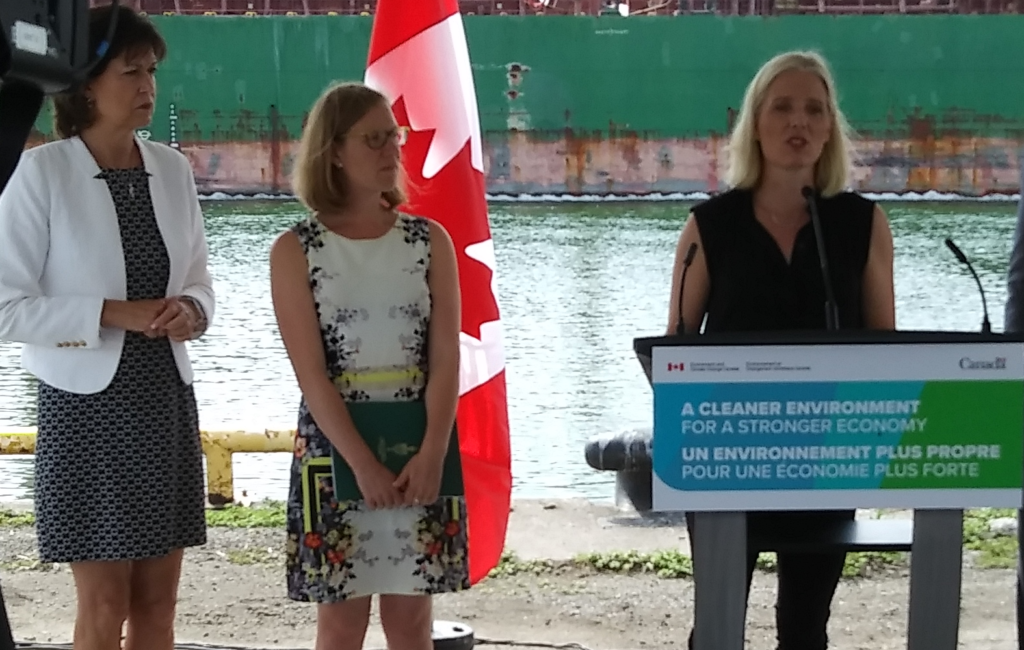 From the left: Oakville North Burlington MP, Pam Damoff, Burlington MP Karina Gould who is also the Minister of Democratic Institutions and Minister of the Environment Catherine McKenna, They were at the Canada Centre for Inland Waters – there is a freighter sailing past them in the background. So Liberal MP’s from Burlington, Oakville and Hamilton East-Stoney Creek were along for the ride when Canada’s Environment Minister Catherine McKenna did a presser at the Canada Centre for Inland Waters (CCIW). It was Karina Gould’s home turf so she moderated.
And fiscal conservatives might have been relieved that it was only a little over a million dollars being awarded for essentially low-level environmental clean up projects stretching over the next three years. It’s chump change, though the Toronto and Region Conservation Authority, which had scored two projects under the federal Great Lakes protection initiative, was out in force to thank the minister for her/our largesse.
 Catherine McKenna – Minister of the Environment. The announcement took place upon the broken pavement out the back of CCIW, which houses the world renowned National Water Research Institute (NWRI). I had spent a lot of time working in that building and it seemed little has changed over the two decades since I’d left. It was great to see so many of my former colleagues still slaving over a hot test tube.
One of the primary purposes of NWRI at its inception back in the ‘70s was to rid the Great Lakes of those nasty algal blooms which choke all the life out of the waters. And there had been progress, and for a while it looked like we had won that battle. But climate change has opened up a whole new challenge. Rain storms bringing nutrient-rich soil from well-fertilized farms and sloppy urban development have combined with warmer water to facilitate renewed algal growth.
Seriously, a million dollars is a pretty modest amount of money, given the three billion dollars the federal and other governments are giving the fossil fuel industry to continue generating greenhouse gas emissions. But every action helps and these projects, restoring habitat and cleaning up the shoreline certainly will help.
And, of course, the feds have more arrows in their quiver. So Minister McKenna wasted no time chastising the Conservative provincial premiers who are wasting tax payer money on court challenges over the carbon tax.
But as I said it was a pre-campaign election event.
 Ray Rivers writes regularly on both federal and provincial politics, applying his more than 25 years as a federal bureaucrat to his thinking. Rivers was once a candidate for provincial office in Burlington. He was the founder of the Burlington citizen committee on sustainability at a time when climate warming was a hotly debated subject. Ray has a post graduate degree in economics that he earned at the University of Ottawa. Tweet @rayzrivers Ray Rivers writes regularly on both federal and provincial politics, applying his more than 25 years as a federal bureaucrat to his thinking. Rivers was once a candidate for provincial office in Burlington. He was the founder of the Burlington citizen committee on sustainability at a time when climate warming was a hotly debated subject. Ray has a post graduate degree in economics that he earned at the University of Ottawa. Tweet @rayzrivers
Background links:
Canada Centre for Inland Waters

 By Ray Rivers By Ray Rivers
August 6th, 2019
BURLINGTON, ON
Ever since I can remember environmentalists have been demanding an end to government subsidies for the oil and gas sectors. And ever since I can remember governments have been ignoring the issue, or have been in denial. And those not in denial keep making promises to end the flow of cash to the energy giants, but never actually do.
 Sustainable for who? Canada by everyone’s calculations leads the G7 when it comes to doling out cash to the fossil fuel industry. And while the International Institute for Sustainable Development (IISD) puts the direct value of Canadian generosity to big fossil at $3.3 billion per year, the International Monetary Fund calls it more like $50 billion after all the externalities are included.
Mr. Trudeau, recognizing the inappropriateness of these subsidies, and echoing long standing Liberal policy, promised during the last federal election that he would eliminate this gravy train. Then he made a similar promise when his government purchased the TransMountain (TMX) pipeline. The NDP, like the Liberals, utter wishful thoughts on the matter, but the national reality just won’t let that happen – at least not yet.
Canada’s is a diverse economy, and three or four provinces rely heavily on the oil and gas sector for their standard of living. And demand for petroleum is still strong. So ending the subsidies would appear as an attack on those provinces and the national economy. Besides there is still some small chance that the Liberals or NDP might win some seats in the prairies.
The Greens are probably the only party which could be counted on to end the freeload, though the probability of them becoming government in the near future is pretty slim – so it’s an easy promise to make. Maxime Bernier’s fledgling People’s Party shuns all subsidies and has criticized the most recent federal gift to the oil execs. But then given current polling he has even a lesser chance of forming government than the Greens, let alone keeping his own seat.
 The sign says it all. Andrew Scheer’s Conservatives are the outliers. Despite criticism of Trudeau on the latest handout to the industry, nobody should doubt where Scheer stands. He represents oil producing Saskatchewan, after all, and like his former boss, Alberta’s Harper, can be counted on to do the bidding of the oil giants.
In fact his recent policy paper on climate change and the environment would see even more subsidies go out to fossil fuel firms presumably looking for cleaner ways of burning even more fossil fuels. He stands shoulder to shoulder with big oil, regurgitating their positions on the new fuel standard and environmental assessment. And his opposition to the carbon tax is all about protecting the oil producers.
But if climate change is the most important issue facing humanity this century, then fossil fuels will have to go, and fossil fuel companies will have to shut down eventually. And alternatives need to be available and put on an even footing financially. According to the IISD, globally, the fossil fuel fellows get four times as much in handouts ($400 billon) as does the worldwide renewable energy sector.
Bernier is dead wrong. Subsidies are an essential part of modern government. They are as essential as fair taxation. If government’s role in society is to provide leadership then it must use all of its tools to tip the scales and nudge us in the right direction. For example, the recently announced federal electric vehicle rebate program helps to level the costs of purchasing a non-polluting vehicle.
 The Hamilton skyline on a difficult day. Subsidies to the oil industry are wrong headed and must and will end. Otherwise how do we move society off oil and gas and onto cleaner electric or hydrogen. The federal carbon tax is expected to raise $2.3 billion this year, all of which will be returned to the public. And that is still at least a billion shy of what the Canadian taxpayers are giving to the oil companies, so they can compensate their oil exec’s with fat salaries, bonuses and stock options. And their product is the poison changing our climate.
 Ray Rivers writes regularly on both federal and provincial politics, applying his more than 25 years as a federal bureaucrat to his thinking. Rivers was once a candidate for provincial office in Burlington. He was the founder of the Burlington citizen committee on sustainability at a time when climate warming was a hotly debated subject. Ray has a post graduate degree in economics that he earned at the University of Ottawa. Tweet @rayzrivers Ray Rivers writes regularly on both federal and provincial politics, applying his more than 25 years as a federal bureaucrat to his thinking. Rivers was once a candidate for provincial office in Burlington. He was the founder of the Burlington citizen committee on sustainability at a time when climate warming was a hotly debated subject. Ray has a post graduate degree in economics that he earned at the University of Ottawa. Tweet @rayzrivers
Background links:
Subsidies for Fossil Fuels – More Subsidies – Canadian Subsidies – Highest Subsidizes in G7 –

 By Staff By Staff
August 1st, 2019
BURLINGTON, ON
The woof woofs need more room to run around.
 Dogs off leash in Central Park – if you have an opinion – speak up The City of Burlington is looking for feedback on the City’s current Leash-Free Area Criteria.
Residents are encouraged to visit getinvolvedburlington.ca/leashfree to review the criteria and provide the City with feedback and suggestions.
The City currently has three public Leash-Free Areas:
• Roly Bird Park (2203 Industrial St.)
• Norton Park (4275 Dundas St.)
• Bayview Park (1800 King Rd.)
With feedback from residents, staff will report back to City Council by the end of this year.

The current Council-approved criteria, described below, is used when the public expresses interest in requesting a new Leash-Free Area.
The survey is looking for resident feedback on the criteria along with any suggestions on the criteria that residents may have.
Current Criteria for Creating a Leash-Free Area
• Parks must be within City of Burlington boundaries
• Leash-Free Area must be at least 0.3 hectares (30 metres x 30 metres)
• All Leash-Free Parks must be enclosed with permanent fencing, which the City will provide as part of the budget process
• An assessment will be made to whether parking will be required at a proposed leash-free site, based on the size of the Leash-Free site, location and any disruption to park function.
• A significant barrier must exist between Leash-Free Areas and children’s playgrounds, splash pads, sports fields, waterfront, cemeteries and residential housing.
• Leash-Free Areas cannot be located beside schools or in the City’s waterfront parks
• Area must be accessible to the public for year-round use
“Leash-Free Areas are great amenities in our parks. They encourage play and socialization for all. We also know there are challenges when developing new Leash-Free Areas, and with the general operation of them.
The city asking you what you think – they want some help shaping the Leash-Free future.”
Ideas, opinions what works and what doesn’t work as well as what could work.. Is the current criteria the right criteria?
Speak up!

 By Pepper Parr By Pepper Parr
July 30th, 2019
BURLINGTON, ON
What started out as a comment made at the annual Chamber of Commerce State of the City address given by newly elected Mayor Marianne Meed Ward may become a rather impressive Trojan Horse.
 Was this initiative a brilliant Trojan Horse? The Mayor made mention of a committee she was setting up – to be called the Red Tape – Red Carpet (RTRC) initiative during which she, along with her colleague ward 1 city Councillor Kelven Galbraith, were to listen to various groups in the city about their concerns with city hall and the help they needed to grow their businesses.
Lurking in the background was a consistent complaint on the part of the developers and a number of businesses that had found it was very difficult to get anything through city hall in a reasonable amount of time
The RTRC team met with
Rural Business Focus Group, Development and Real Estate Industry Focus Group, Large Business and Manufacturers Focus Group, City Staff and Partner Organization Focus Group, Small Business Focus Group and heard what expected – the departments don’t talk to each other- the agencies (Fire, Education, Region, Conservation) are brought into the picture one at a time.
While Meed Ward was meeting with the various groups – all of which were closed to media – a consistent trait we have noticed from a Mayor who touts her 22 years as a journalist with a high regard for the role the media plays, the Burlington Economic Development Corporation was in the process of looking for a new Executive Director. Anita Cassidy has been serving as the Acting Executive Director for more than a year.
Her predecessor, Frank McKeown, who was at one point Mayor Goldring’s Chief of Staff and went on to run the BEDC, fully understood what the job was – keep the business we have and find new ones – he was just never able to land a really big one.
McKeown thought he was going to be able to put together a partnership with a German consulting group that wanted to get into the North American market. McKeown had his eye on a partnership with McMaster’s DeGroote School of Business and the Fraunhofer Institute for Industrial Engineering – it didn’t work out – the Germans chose Hamilton instead,
Frank McKeown and Mayor Meed Ward never broke bread together – they had strong differences of opinion on what economic development was all about.
 Frank McKeown, asking about how politicians can handle complex issues when voters tend not to be informed and don’t have the background needed to arrive at decisions. Some think that McKeown resigned as head of BEDC when he could see that Meed Ward was going to be the next Mayor. McKeown always did have a good eye for figuring out which was the wind was blowing and whose sails it was going to fill.
While he ran BEDC, McKeown created TechPlace – a location where small start-ups could move in for a period of time and find their footing and then move out of TechPlace and set up shop in Burlington and grow as a new business opportunity for the city.
During this mix of events Mayor Meed Ward got invited to take part in a “Tale of Two Cities” with Oakville Mayor Rob Burton who explained to a good audience at the Performing Arts Centre that economic development should be an in house operation.
There are dozens of business people with tonnes of experience in drawing new business to a municipality that will tell you it is nuts to put that kind of an operation in city hall. Views are clearly divided on that issue.
At roughly the same time Burlington learns that L3Wescam is going to move out of the space they are in on the North Service Road to a new site in Waterdown. The Mayor was caught off guard and had to scramble to put a decent spin on the news.
 L3Wescam will be leaving these premises for a new purpose built location in Waterdown. It isn’t clear if Hamilton had gotten to L3Wescam and found them a deal they couldn’t refuse; they did that with International Harvester who were all set to move their parts distribution operation from Burlington to Mississauga – then they got a great deal from Hamilton and a time frame that worked for them.
The new Mayor had ideas of her own – she had begun toying with the idea of creating an MDC – Municipal Development Corporation that would be an in-house operation. In the material she prepared she went so far as to describe the job the Chief Development Officer of such an organization would be doing.
“Establish a position at City Hall to act as our Chief of Business Development, serving as a primary outreach for attracting new businesses to Burlington, overseeing and expediting applications through the system and reporting progress and obstacles regularly to City Council and the City Manager
During the July 15th Council meeting- the last one until September the Mayor asked her colleagues to support her idea and move it forward – the support she needed wasn’t there – council deferred the matter to the September meeting when the consultant’s report on the future of BEDC was in hand.
 Anita Cassidy finds herself facing an uncertain future over decisions she didn’t make. One wonders what Anita Cassidy was thinking as she watched this parade of events pass her by.
The city, which provides most of the BEDC budget is current having a study done on what their role should be. As Mayor, Meed Ward sits on the BEDC Board.
Economic Development is critical to the growth of a municipality – some do it very effectively – Welland Ontario is a great example. Others slip and slide around and lose opportunities that they didn’t even see.
The business of attracting a corporation to move to town is really a networking game – you need someone who knows the players, plays a decent game of golf and has a great story to tell.
Burlington has the elements of a great story – parts of which are buried because their value is not perceived.
What isn’t clear yet is whether or not Mayor Meed Ward has the capacity to listen and to surround herself with people who she trusts and will rely upon when it comes to the complex process of how decisions are made. The jury is out on that one – and when it does return it might well be a hung jury.
There is one final irritant – a fly in the soup if you will.
Tech Place has just under five years left on a lease that has a sliding scale of rent increases. In the final full year of the lease rent will be a combination of net rent and additional rent for a total of $301,877 in the 6th year. That is a big nut to crack in anyone’s language.
TechPlace is a program of the BEDC, it has a staff of 1.5 people and an average annual contribution from BEDC’s core budget of approximately $220,000 per year.
Gross rent over the 6-year contract varies from $24,000 in year 1 to an annual cost of $301,000 in the final year.
There is basically nothing in the way of a revenue stream and while there are some bright spots in the Tech Place story it isn’t enough to cover the rent or justify the expense.
In material from BEDC we learn that “TechPlace is a one-stop destination for new and growing technology companies. TechPlace was established to support Burlington’s Strategic Plan 2015 – 2040 that calls for “Innovative, entrepreneurial businesses have settled or developed in Burlington. The city has helped create the technological support, business supports, infrastructure and educational environment to attract start-ups and growing businesses” and to “Create and invest in a system that supports the start-up and growth of businesses, innovation hubs and entrepreneurship.
“Following best in class ecosystem research and stakeholder engagement conducted in 2017 a clear need to have a physical space to build a successful entrepreneurial ecosystem in Burlington was identified to create connectivity, vibrancy and tell our entrepreneurial story. Burlington Economic Development Corporation became the change champion and opened TechPlace to accomplish the City of Burlington Strategic Plan in a way that was aligned with community need and stakeholder input.”
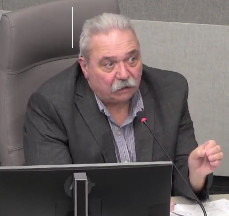 Angelo Bentivegna wanted more information on that Tech Place lease. This is the kind of language developers trot out when defending applications. No one appears to have asked the hard question: How are we going to pay rent of $300,000 in the last year? Ward 6 Councillor Angelo Bentivegna kept asking questions about that lease – bless him for that – no one else was.
“TechPlace is focused on supporting the scale up and growth of high potential companies through its Launch Pad program and a host of wrap around services delivered through partners such as Haltech, Angel One, Mentorworks, Mohawk College, McMaster University and Halton Region Global Business Centre.
“In addition, BEDC has created a “Soft Landing” program to use as a unique business attraction tool that allows companies considering a location in the west GTA to establish a footprint in Burlington and begin operations while BEDC supports their long term business relocation to Burlington through its traditional business support services.”
There is some pretty fancy language in the BEDC material – the results, while interesting, are not going to do much in the way of changing the makeup of the commercial sector in the city.
 Since TechPlace launched in 2017 it has hosted over 10,000 visitors, 200 events, attracted 13 LaunchPad companies, creating a strong business attraction brand and value proposition for Burlington. Results since inception are: Since TechPlace launched in 2017 it has hosted over 10,000 visitors, 200 events, attracted 13 LaunchPad companies, creating a strong business attraction brand and value proposition for Burlington. Results since inception are:
Total LaunchPads -13
Total LaunchPads from outside of Burlington – 10 of 13 Graduates – 7
Graduates that stayed in Burlington – 5 of 7
The BEDC material adds: “There have been a number of recent changes to the local start-up support ecosystem including the launch of Nuvo Network and the review of the Regional Innovation Centre model by the provincial government including Haltech.
“This creates opportunities for reviewing TechPlace’s operating model and determining whether BEDC delivering TechPlace activities directly or spinning off the activities to a partner can create the same benefits for Burlington with a different operating and financial model.”
“As part of the overall BEDC review, it is worth reviewing the efficiency, effectiveness and optimal structure and mandate of TechPlace to determine the pros and cons of retaining it as part of BEDC or spinning it off to an independent provider. The review would include a cost-benefit analysis of the current investment in TechPlace and what it produces in business attraction, versus other strategies for business attraction (e.g., dedicated staff) that don’t rely as heavily on physical space.”
This amounts to Corporate Spin on a situation that is unraveling quickly.
Is the BEDC signalling that Tech Place has not panned out the way they had hoped and that it is time to bail out?
Ward 1 Councillor Kelven Galbraith was taken on a tour of the McMaster Innovation Park and had this to say: “It was amazing to see the business success stories that have emerged from the park and the continued investment into their facilities and operations.
‘The City of Burlington and Burlington Economic Development Corporation (BEDC) looks forward to a great business relationship with the McMaster Innovation Park in the future”. That train may have already left the station.
 Mayor Meed Ward has a strategy and a long term objective – don’t get in the way. The Mayor wasn’t all that interested in waiting for the result of the BEDC review – she had a job description in her hand for the person who is going to bring some life to attracting new enterprises to the city – all she needed was three of the six votes from her colleagues – they weren’t forthcoming.
Tech Place was seen by former Mayor Rick Goldring as one of his success stories – he really wanted it to work.
Wanting just isn’t enough – is it? The city just might have to suck up that rent cost and look for someone who will take over the lease.
Sean Saulnier over at NUVO One isn’t likely to be the white horse the city needs.
The financial reckoning will take place and a new story line will be spun out of city hall. Burlington learned to leave well enough alone when the New Street Diet proved to be a dismal failure. Are we about to repeat that performance?
Don’t expect to see much in the way of transparency in what happens next – and give up on the idea of holding anyone accountable.
Salt with Pepper is the musings, reflections and opinions of the publisher of the Burlington Gazette, an online newspaper that was formed in 2010 and is a member of the National Newsmedia Council.

 By Staff By Staff
July 30th, 2019
BURLINGTON, ON
A devoted Gazette reader popped us a note. “You might want to read this over and perhaps share it.” The article, which is rather long, is on the value (or lack thereof) of public engagement.
Ruben Anderson wrote the piece on August 6, 2018. He mentions an article with the headline – “Most Public Engagement is Worthless” which he said grabbed his attention.
That article launched Anderson’s thoughts.
“I think most public engagement is beyond worthless. I think it actually corrodes the relationships we need in order to build a strong town. Most public engagement, as it is currently conducted, makes our cities worse places.
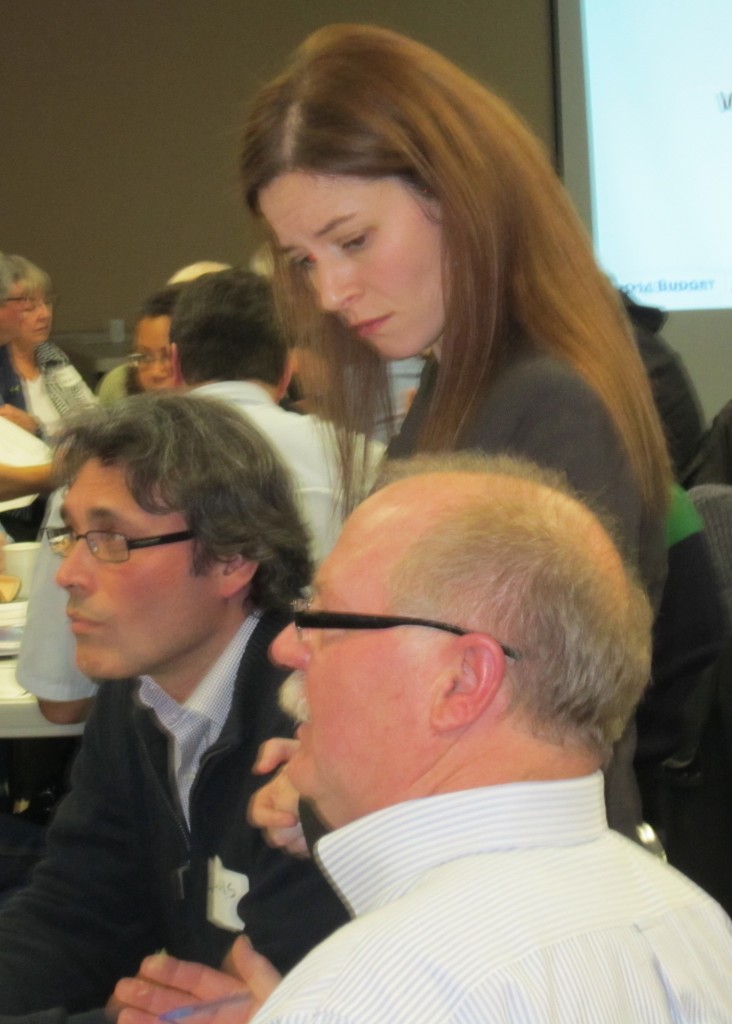 Finance department staff explaining a part of a budget during a public forum. “Does this mean that I am saying we should abandon public engagement? Most definitely not. But I think we need to understand behavior, relationships, and expertise a lot better if we are going to do good with our consultation efforts instead of harm. Public engagement needs to be done well, because it would be better to do nothing at all than to corrode the public’s trust in City Hall and in each other.
Let me tell you a story.
I was working for the City of Vancouver’s Sustainability Group and was assigned to a large urban planning process. Consultation was said to be critical, necessary, jugular—and so we dog-and-ponied with our flip charts and sticky notes and dotmocracy.
We asked people the question, “How could Vancouver be more sustainable?”
Solar Panels! they told us. Windmills! Plant trees! Ban plastic bags! Ride bikes!
Golly. Solar panels?
Here I am working in a Sustainability Department and I never thought of solar panels. How could I have missed that? Solar panels! And bikes? Wow. Just wow. What a fool I was! My eyes are opened!
What I am trying to describe here is how terribly insulting this process was to everybody involved.
We had asked a question that could produce nothing but disrespect for the experts who have dedicated their education and careers to reducing environmental impact. Of course we knew about solar panels.
And we had asked a question that the members of the general public were not equipped to answer, because they aren’t experts. There are some good reasons why solar panels are not installed faster—it is almost always a better idea to insulate your home, weatherstrip and draught-proof first. You reduce your own energy demand before you put on solar panels.
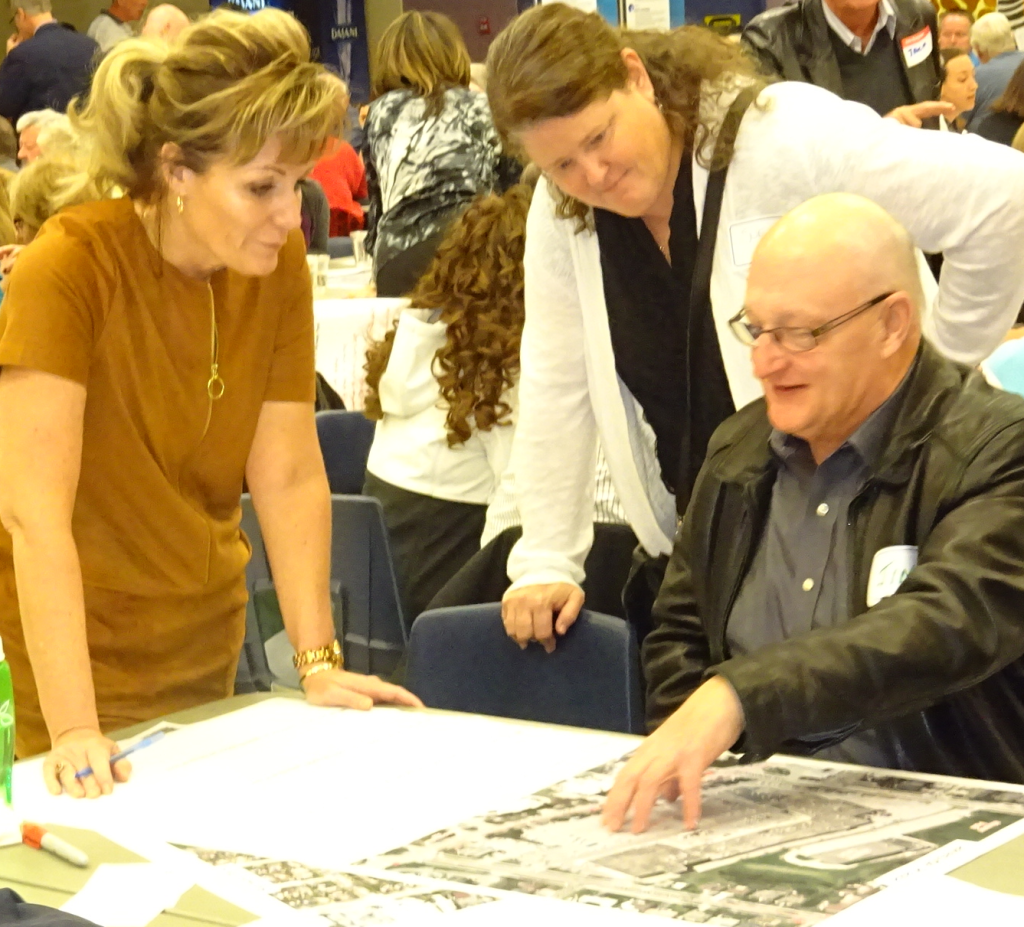 Jennifer Johnson on the left listening to a residents ideas at Lakeside Plaza visioning exercise. When the report and recommendations come out, the public sees nothing that resembles what they asked for—they wanted solar panels and they got weatherstripping. They too feel disrespected. They gave their irreplaceable time, hours from their one and only life, and look what they got.
They had to give something up in order to come to the consultation, and nothing good came of their time because they weren’t asked questions they could meaningfully contribute to answering.
This is not how you build a trusting relationship: a strong foundation on which to work together. This is how you corrode trust.
Another story: the city I now live in, Victoria, BC, recently began installing “all ages and abilities” bike lanes after a significant consultation period. At a couple of the consultations, big maps were laid out so people could draw where they thought bike routes should go.
If you’re having the public draw bike lanes, think about why. What expertise do they have that your bike planners don’t?
 Does the clearly coloured bike lane make it safer? Only if car drivers are aware of why the colouring is in place. To be quite blunt, if your bicycle transportation planner does not have a very clear idea what routes would balance geography, access, cost, safety, behavior change, etc. then they are incompetent and should be fired.
If your planner is not incompetent, then they are probably well-read on the past couple of decades of practical experimentation with bike infrastructure. They probably know the current best thinking on the sorts of places bike lanes should connect and serve. They have probably seen a hundred examples of creative solutions to integrating bikes into cities. They have been paid by the city to learn these things, and probably have done a bunch more research on their own because they are transportation geeks.
So the public was asked to come in and draw routes. The public doesn’t know anything about how many dollars per kilometer each option costs. They don’t know about lane widths, and how wide the city right-of-way is. They know nothing about other things that may be important, like planned changes in sidewalks, utilities, and developments.
We ask people who have none of the education, experience or knowledge needed to make proper decisions to come in and draw routes, and we ask the City staff to sit there and be polite at the ridiculousness that pours out. Can you imagine how the staff feel about giving up their evening with their family, after a day’s work, to go be polite to people who are unaware of virtually all the limiting factors?
And so the public input is ignored, which in this case is the right thing, and the public feels abused, disrespected, undervalued and duped, which also seems like the logical outcome of the consultation.
What Are We Trying to Do?
I really mean this question. What are we trying to do when we do public engagement?
Why are all these people in this room? What are we trying to accomplish? Before we gather people for public consultation, we need to be clear and honest about what we are trying to do. Then, if consultation is the right solution, we can design a process to fill that need.
Are we trying to get ideas?
Our culture loves Ideas! We have Idea Jams! Idea City! TED Talks!
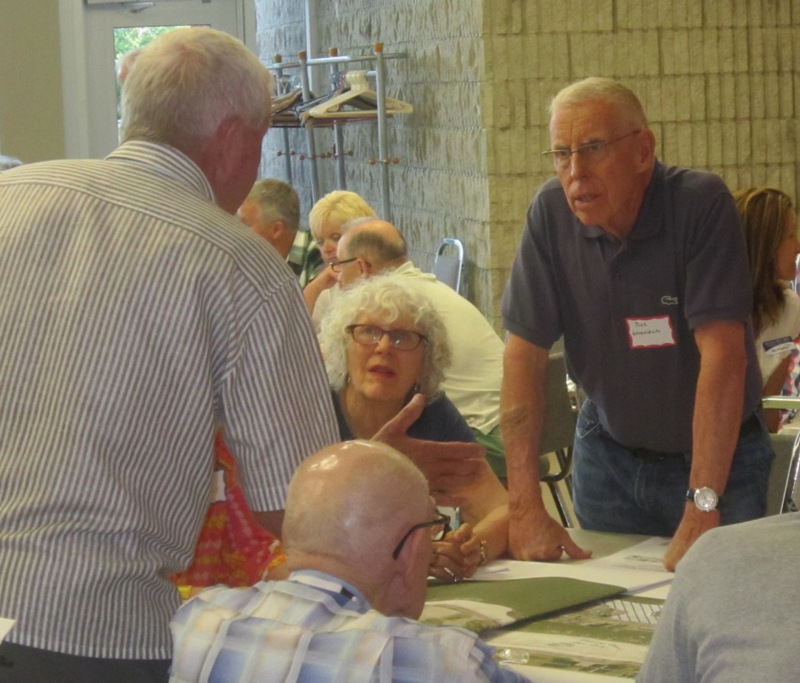 Bob Wingfield, a long time Burlington resident differing with former ward 4 Councillor Jack Dennison. Lack of ideas is almost never the problem, as I have argued elsewhere. The problems we face are usually a lack of social cohesion or a lack of money—and a lack of money often also indicates a lack of social cohesion; not enough people care about the project to tolerate a tax increase to pay for it.
Even if we did need more ideas, consultation doesn’t work to generate them. I have a degree in Industrial Design, so I actually took classes in generating ideas. As a working designer I had to constantly generate new ideas. I can tell you, there is not much of a worse way to generate ideas than to put a bunch of strangers with competing interests who are untrained in brainstorming techniques into a room for three hours.
Are we trying to build social license?
Superficial exercises like dot-voting often fail to respect and take advantage of the expertise of either professionals or the public, and leave both feeling insulted. (Image source: Wikimedia Commons)
Maybe. One of the knee-jerk responses every planner is familiar with is “There was no consultation.” So, putting out a plate of stale cookies and setting up a sad dot-voting exercise neuters that response. Maybe there was nothing consultative about it, but the sign in the hall said “Public Consultation This Way,” so I guess there must have been a consultation.
Bringing many people with different goals together behind one project is quite a big task. Clearly a real program to build social license would take a lot more time and care than your average public meeting. Planners know how to hold value-based discussions, but I don’t know that I have ever seen them use that skill in the processes I have been involved in.
If you need to build social license, maybe you should throw street parties; have a barbecue.
Are we trying to acknowledge people?
I have come to think that engagement tries to acknowledge the public’s plaintive cry, “Don’t forget me.” I think people often don’t need to win; they just don’t want to be forgotten. But as I described above, the outcomes of our processes sure look like they were forgotten.
I wonder what it would be like if the design team went through the plan inch by inch, narrating the compromises, costs and failures, the choices they made, and the specific comments from participants. “Albert and Ruth, who live in Fairfield, are concerned that we expand the songbird habitat. We did that by specifying different landscaping from the typical pom-pom tree and grass lawn. The west side is a native plant garden, intended to be wild and seldom entered by people.”
Are we trying to let off steam?
Issues sometimes get contentious, and letting people vent and feel heard seems like a valid goal—it is just that our public meetings often seem to do the opposite. They actually increase tension instead of releasing it. How could we vent most effectively? Could we play dodgeball? I mean literal dodgeball, where we try to smoke the people we disagree with as hard as we can with a fast-moving ball.
I understand that dodgeball does not resolve what we think of as city planning issues—but neither does the current model of public consultation. And the current model often increases tension between parties, whereas at least dodgeball would dissipate some of it. So there is a very real, serious case to be made that dodgeball would produce better outcomes from our consultations than any amount of sticky notes and dotmocracy ever will.
That is a sad commentary.
Misplaced Expertise
It is clear the public is dissatisfied with much public engagement, and do not feel they were actually listened to.
In the Facebook comments on Chuck’s article, Nancy Graham said “A lot of [consultation] is simply for show and to pretend you are being heard when the leaders have already decided the results they want.”
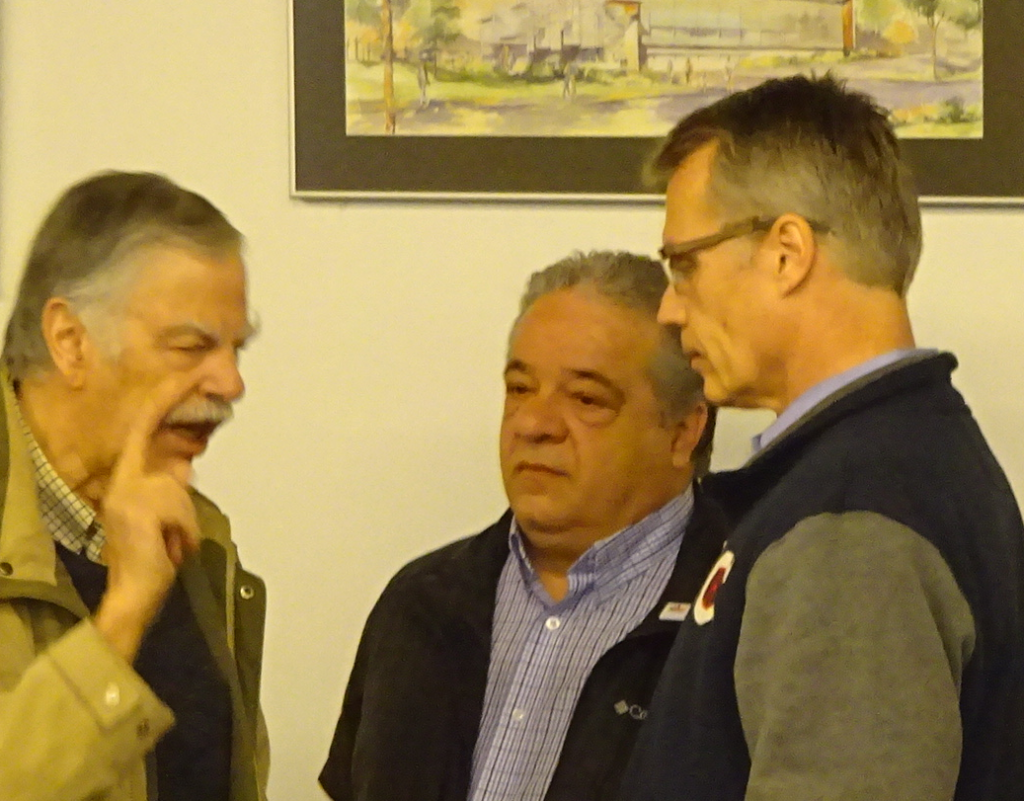 An unhappy transit user letting Director of Transportation and former Mayor Rick Goldring know what he thinks. Why would leaders do what they want? Sure, maybe for self-interest and personal profit in some cases. But perhaps it’s generally because they think they know better and are trying to make the world a better place. This belief is not unfounded; presumably, they have years of education and on-the-job experience and privileged knowledge of the tricky terrain of this particular troubling issue.
Expertise is unfashionable right now, partly because our society is not very good at understanding who is expert at what, so we give too much power to some people and not enough power to others.
One of the most enduringly popular Strong Towns articles is Chuck’s Confessions of a Recovering Engineer, in which he lambasts his younger self and his former profession in rich detail. He describes how he would arrogantly ruin neighborhoods and destroy streets, thanks to his confidence that his asphalt was for the better. He was the expert.
He was an expert in engineering, who ruined the place. Citizens were promised something better, but what they got was something worse.
And most of our cities have many Chuck 1.0s. Many of us live in cities that were impaled with freeways through the core. We travel on streets that are unsafe by design. The sense of place does not show up in engineering standards manuals.
And yet it would be silly to break out the dotmocracy to specify how to repave a road. It doesn’t matter how you feel about finely crushed rock compacted in the base layer; it matters how it performs with vehicles on it.
Engineers should be expert in the strength of materials and construction methods. They are in no way expert in human behavior, nor are they experts in public opinion. They should not be making political decisions or urban design decisions.
The engineer’s role, which has grown to have so much influence in so many cities, should really be quite technical and fairly powerless. They should have the job of implementing decisions made by others, and within that, their expertise for materials and construction should be completely respected. They are the experts at that.
Sadly, we don’t see residents as experts. This is a critical and corrosive mistake. Of course, they certainly are not experts in how to reduce greenhouse gases, or pave roads, or pick bike routes. They should not be picking beams for a bridge.
But citizens of a city do know how the built environment makes them feel, and how they would like to feel.
They are experts in how increasing taxes will stress them out. They are experts in hidden secrets of their streets and alleys. They are experts in the amenities they want for themselves and their family. They are the only experts.
Their expertise should be respected.
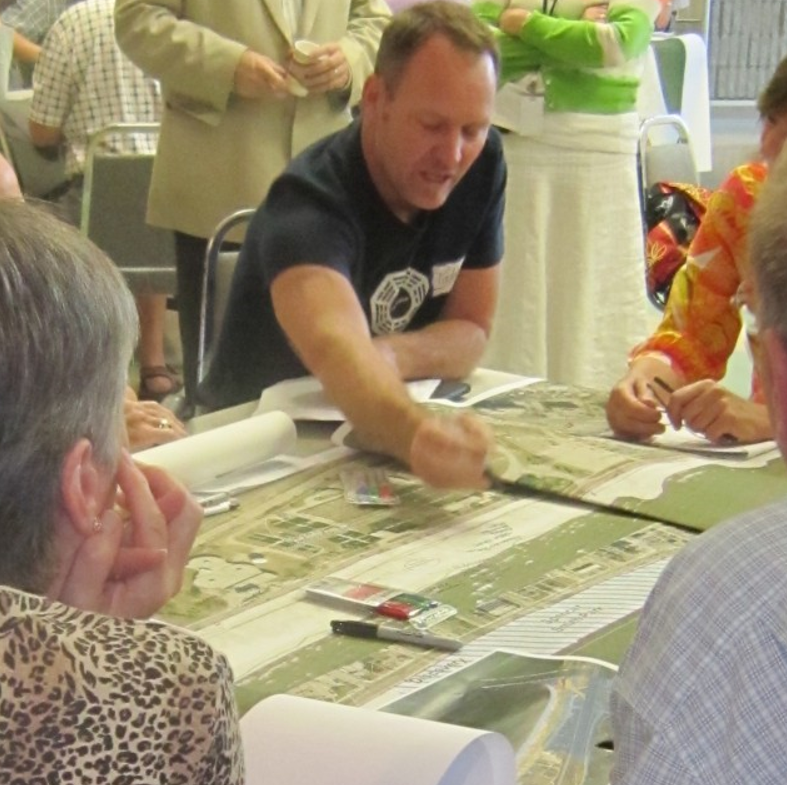 Beachway residents looking at early maps “We should only consult with residents when they are the ones that can best answer the question at hand. But in those moments, they should be treated as the experts they are.”
One of the most impactful examples of this I have seen comes from when Oregon had single-payer medicine and was trying to ensure tax dollars were spent most effectively. Experts rated every medical procedure and pharmaceutical by its cost and the quality of life it gave, then ranked them from best to worst. Right up at the top was treatment for pneumonia, and at the bottom was life support for babies born without a brain.
And then they added up the medical costs and the current tax revenue, and drew a line on the list where the tax dollars ran out.
Medical experts made the list of treatments. And then residents—experts in the impact of sickness on their family and community, and experts in their personal budget—got to decide what should be covered.
Essentially, the public got to choose how many people would die. Would you like to cover more procedures? Simple, just pay more taxes. Should we spend one million dollars per year keeping an 80 year-old alive? Nope.
And so the line is adjusted.
What Chuck describes in “Confessions of a Recovering Engineer” is that the choice of how many shall die on our roads has been delegated to engineers, who prioritize speed over life. That is wrong. Engineers are not qualified to make that choice. Only the citizens are experts in how many funerals they would like to attend each year, and how much tax they are able or want to pay—and it turns out they prioritize safety over speed.
So far I have talked about engineer experts and resident experts. But in his latest article, Chuck also talked a lot about design, referencing Steve Jobs. In fact, commenter Kevin Adam noted the similarities between Chuck’s article and corporate Design Thinking.
As I mentioned, I have a degree in design and worked as a product designer—so naturally I think design is incredibly important. Designers bring a different expertise to the equation that residents and engineers typically don’t have.
The old joke about the iPhone is that if you asked people what they wanted in a telephone, they would have said, “Longer cords.” That is the product of a worthless consultation.
So to avoid that, Chuck says, “get on with the hard work of iteratively building a successful city. That work is a simple, four-step process:”
Humbly observe where people in the community struggle.
Ask the question: What is the next smallest thing we can do right now to address that struggle?
Do that thing. Do it right now.
Repeat.
Let me reframe this list as a design process.
1. Humbly observe where people in the community struggle.
Almost every word here is pure gold so I am going to break it down.
Humbly…
Arrogant, rock-star designers may be fine for chairs or blenders, but as I have already said, only the residents are experts on living in their city. To get good outcomes, the designer must approach with humility, in service of the city and its people.
…observe…
Asking people what they want is often very ineffective. Most people aren’t trained to imagine seemingly impossible things, like a stylish supercomputer that fits in your pocket.
Good public opinion pollsters have to distill opinions out using oblique questions and the discernment that comes with years of experience. Angus McAllister, CEO of McAllister Opinion Research, said, “Most consultation and opinion research is like eating a Big Mac—empty, unhealthy and dissatisfying.
Humans are poor at noticing the drivers of our own behavior. We often behave for one reason, and then seek an explanation for why we acted that way. Typically we just pick something reasonable-sounding even if it is totally unrelated.
For example, if you ask someone why they come to a certain café, they may respond that it has lots of parking. So, if you remove the parking and they keep coming, you know parking is a post hoc rationalization. In fact, they like the way the light falls on the patio, or the service, or the smell reminds them of their grandparents’ kitchen.
Changing the parking is a design prototype. Nothing happens? Change it back and do something different. It is not just whole projects that need to be iterative; the stages within a project also benefit from iteration.
So good designers have to ask lots of careful questions, but observing behavior is critical. You can ask people what route they walk, but when you observe the paths worn through the grass, you have real data.
…where people in the community struggle.
We hold up Gods of Technology like Elon Musk and Mark Zuckerberg, but they are solving their own problems—rich tech bro problems. They don’t care about sidewalks or corner stores; they have driverless cars and drone delivery!
2. Ask the question: What is the next smallest thing we can do right now to address that struggle?
A Strong Towns principle is that it is less risky to make many small bets than one huge gamble. It is also often strategic, because it is much easier to get permission to do a small thing.
From a design perspective, it is easier to manufacture a spoon than it is to build a kitchen mixer with hundreds of parts—but both can whip up a cake.
3. Do that thing. Do it right now.
Actually, before you do the thing, I would like to add one more step.
2b. From a design perspective, it would sure be awesome if you would collect some data first, to test your Theory of Change.
Here are some Theories of Change:
If we paint a bike lane here, more people will ride bikes.
If we narrow this road, cars will drive slower.
If we widen this highway, we will eliminate congestion.
So, when we plan our interventions, we are using a Theory of Change—whether we have stated it or not—and it is important to collect data to test your Theory of Change.
Collecting data can be very tricky. For example, if you stripe a bike lane, you may see more bikes on that road. Are they new cyclists, or did the same old cyclists just change routes? If your goal is more cyclists, that matters.
So, collect data that will actually test your Theory of Change. As far as I am concerned, the number of hits on your website is generally useless data. We want to count real world change.
3. NOW you do the thing.
Do the thing, then observe. What actually happens in the real world? What do people do—not what do they say, what do they do? Do they drive slower, ride more, shop locally, add a basement suite, plant a tree—whatever. What do they do?
This lesson is one of my favorite from design school. What people do is the only measure that matters. My teacher said, “The users tell you what your design is.”
 Did the public have any input in the design of this bench. Did the people who approved the design every sit on the bench? Imagine you have designed an amazing bench—but nobody sits on it. The skateboarders, however, love it.
Well, then you have not designed a bench, you have designed a skate feature. It doesn’t matter what you think you are designing, it matters how people use it.
I hope you find this to be liberating. If you are struggling with a doorknob, or a toaster, or a sound system or your car’s windshield wipers, it is not your fault, it is just bad design. Bask in this insight while you scroll through Gracen Johnson’s sad collection of design failures, #PlacesIDontWantToSit.
So collect the data, and compare it to your Theory of Change. Did it work, or is your theory garbage? If it is garbage, it is a relief you only made a small bet.
4. Repeat.
“Good designers have to ask lots of careful questions, but observing behavior is critical. You can ask people what route they walk, but when you observe the paths worn through the grass, you have real data.”
Collect data and observe the results, because it is a drag to keep repeating the same mistake over and over again. Watch what works, and repeat that.
Now, in this list, consultation just disappears, and I think that is a bit hasty. I think the design experts should humbly observe where the community is struggling—but where do you start observing?
 Blowing off steam – certainly not communicating. This is when you ask the experts. Consultation can map hot spots. Consultation can prioritize which hot spots to address first. If you need to know how it feels to live in a city, where the friction points are, and what is most beloved and cherished, residents are the only experts. Design a consultation to harvest their expertise, and then act on what they give you.
Consultation is a very small part of the overall process, but can be useful and important.
We need to be more aware of different kinds of expertise, and who has it. Each expert—engineer, resident, or designer—only specializes in a narrow field, and we mustn’t ask them to do each other’s jobs.
Otherwise, we disrespect everybody involved, and we corrode goodwill and trust on all sides.

 By Ray Rivers By Ray Rivers
July 26th, 2019
BURLINGTON, ON
“Chocolate milk saved my son’s life” – Andrew Scheer
No that wasn’t the latest idiotic outburst from America’s Donald Trump. This is a serious comment from the political leader currently ahead in the polls going into Canada’s next election. Andrew Scheer is shunning the evidence provided by Canada’s leading health scientists and dieticians and shamelessly catering to the dairy and meat producing industry.
 “Chocolate milk saved my son’s life” – Andrew Scheer Deja vu? You bet! This behaviour should hardly be surprising, coming from someone who was a member of Stephan Harper’s ideologically-driven government. Science and knowledge were considered a potential threat to their lifestyle, or at least their ideology. So show me no evil… Didn’t Harper eliminate the long form census and muzzle government climate scientists?
The Canada Food Guide, which first appeared in 1977, is an integral component of Canada’s universal health care system. As we know, diet and exercise play a huge role in determining the state of our health. And in a publicly funded health care system with limited resources, it just makes sense, economically and holistically, to eat well in order to avoid problems that may land you in the doctor’s office or the hospital.
Former versions of the guide had been criticized by some health professionals as just another piece of advertising for the animal food industries, and thus misleading, inaccurate and past its best before date. A decade later and with a different government at the helm, the new guide has attempted to finally address that criticism.
 Obesity, especially in children, is a major public health issue. Meat and diary are still there but meat is now, along with nuts and legumes, just a source of protein. And water is favoured over milk as the drink of choice. As we know, not everyone can tolerate lactose and not all adults can metabolize milk, which questions its value as the best dietary source of calcium. And haven’t a number of dairy products, including the chocolate milk Scheer feeds his children, been linked to the rising levels of obesity and diabetes in our society?
It is understandable that representing a riding in Saskatchewan, a province where agriculture along with oil and potash make up the economy of the province, that Andrew Scheer would feel compelled to defend farm interests. But not all farmers are dependent on animal husbandry and there are always other agricultural production options for those who currently are.
Scheer has been taken to task for claiming that ideology and not science was behind developing the new food guide. Having only ever been a politician, except for a brief stint selling life insurance, how would he possibly know that? And in fact he doesn’t – he has it wrong. It is he who is the ideologue.
 The new Canada Food Guide is a science-based document which has been extensively researched and was crafted following wide ranging consultations across our society. It has taken a decade for the officials responsible to muster the courage to come forward, break with tradition, and tell it like it is. The guide is signalling that it’s time to cut back on meat and milk and salt and sugar… and fast food. The new Canada Food Guide is a science-based document which has been extensively researched and was crafted following wide ranging consultations across our society. It has taken a decade for the officials responsible to muster the courage to come forward, break with tradition, and tell it like it is. The guide is signalling that it’s time to cut back on meat and milk and salt and sugar… and fast food.
Something is unhealthy in the state of Canada… and it’s our eating habits. If our reliance on fast food and excessive meat and dairy is normal, then our rates of obesity, diabetes, heart disease and cancer must be too. If we want to change the outcomes we need to change the inputs, what and how we eat.
To that end the guide promotes cooking at home rather than the ever growing practices of eating out and ordering in. Nothing could be more traditional than that, especially for a staunch ideological conservative like Mr. Scheer.
 Ray Rivers writes regularly on both federal and provincial politics, applying his more than 25 years as a federal bureaucrat to his thinking. Rivers was once a candidate for provincial office in Burlington. He was the founder of the Burlington citizen committee on sustainability at a time when climate warming was a hotly debated subject. Ray has a post graduate degree in economics that he earned at the University of Ottawa. Tweet @rayzrivers Ray Rivers writes regularly on both federal and provincial politics, applying his more than 25 years as a federal bureaucrat to his thinking. Rivers was once a candidate for provincial office in Burlington. He was the founder of the Burlington citizen committee on sustainability at a time when climate warming was a hotly debated subject. Ray has a post graduate degree in economics that he earned at the University of Ottawa. Tweet @rayzrivers
Background links:
Fact Checking Scheer – Misinformation – Canada’s Food Guide –
Food Guide Explained – Industry Concerns – Scheer and Bias –
Milk and Calcium –

 By Pepper Parr By Pepper Parr
July 25th, 2019
BURLINGTON, ON
My friend Vince Fiorito, one of the best environmental advocates Burlington has, taught me that there is nothing that comes before the environment – not jobs, not the bank rate, not even who we elect as Prime Minister – without an environment that meets our needs – nothing else matters.
And, he adds, that environment is something we play a very large part in creating; given the climate changes we are going through now – it is clear that we have not done a very good job with some thinking that we are never going to be able to recover if we don’t do what has to be done before it is too late. The planet will go through another stage of extinctions. We have had three so far – the planet survived the creatures on it didn’t.
This time WE are the creatures on this planet.
That lesson – that the environment comes before everything, taught me something – that in every situation, organization or endeavour there are things that have to come first.
After publishing a report on the risks Burlington faces with its labour force the Fiorito lesson struck me.
The only thing that matters at city hall are the people who enter the buildings every day to work for the people that pay them.
Unfortunately those people do not seem to be able to pull together very well. And we aren’t paying them what other municipalities are prepared to pay them.
 Director of Human Resources Laura Boyd In her report to city council Director of Human Resources Laura Boyd spoke of some of the feedback her department had received and added that:
“When the results were further analyzed, it became apparent that communication within the organization diminishes between hierarchical levels.
“Specifically, between the Burlington Leadership Team and the Supervisors/Manager level and then between the Supervisors/Managers level and their direct reports.”
No wonder we are in the mess we are in.
My question was: How long has Boyd known this? Did she send her message up the food chain to the city manager at the time? Did she alert the Mayor?
The Gazette has listened to Ms Boyd report to city council in the past – we never heard before what she had to say earlier this month.
Staff is what counts. It is their energy, their creativity and their willingness to put in that extra effort that makes a city work.
They aren’t putting in the energy apparently, partly because they are not being paid as well as their peers in other municipalities.
Have you ever seen a city staff member wearing a T shirt with the city logo? Not much pride in working for the city of Burlington.
In the past few days we have seen comments from people who once worked for the city. Some comments could be sour grapes. We’ve noticed that many of the people we got to know are no longer with the city.
A major change in the culture of the city’s work force and the way they are recognized is needed. That falls on the desk of the city manager.
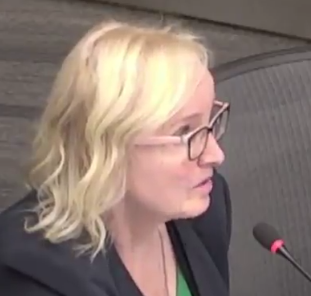 Laura Boyd – Has worked in one city department during her 29 year career. If we have the numbers right Ms Boyd has been with the city for 29 years – which suggests getting close if not eligible for retirement. All her work experience is with the one department – Human Resources – that too might be part of the problem.
In her report to Council Ms Boyd reports that something close to 20% of the leadership positions will see retirements in the near future.
That gives the city manager some room to find the people that are needed to bring the ship of state around and find more favourable winds to move it forward.
Related news story.
Troops are not happy.
Salt with Pepper is the musings, reflections and opinions of the publisher of the Burlington Gazette, an online newspaper that was formed in 2010 and is a member of the National Newsmedia Council.

 By Pepper Parr By Pepper Parr
July 23rd, 2019
BURLINGTON, ON
In his 33 years of puddle jumping Scott Stewart went from Peel Region to Mississauga, to Brampton, then Hamilton, then Burlington, and on to Guelph where they appointed him the Chief Administrative Officer – a job that eluded him for far too long in Burlington.
 General Manager Scott Stewart with Deb Franke of AJ Braun and Craig Stevens discuss the welding of beams for the Pier. Stewart was the General Manager who pulled together the team that ensured the city got it right the second time around. Scott was always a hands on leader. He would spot talent that others didn’t see and grow it, groom it and nurture that talent to the point where it could lead.
Burlington’s city council turned Scott Stewart down twice – he took the hint and went north to Guelph – a city he likes, partly because they own a railway line that Stewart had turned into a competitive advantage for the city.
 Stewart will wear the sweater to the office the day the Maple Leafs win the Stanley Cup. Leadership positions within the municipal sector are attained by moving from location to location – taking the experience gained at one and applying it at another. Burlington lost an opportunity when it chose James Ridge over Scott Stewart – look where that got us. Well, it did rid the city of an under-performing council.
As the Chief Administrative Officer Stewart just might have to move from Burlington, a city where he has deep roots.
Salt with Pepper is the musings, reflections and opinions of the publisher of the Burlington Gazette, an online newspaper that was formed in 2010 and is a member of the National Newsmedia Council.

 By Ray Rivers By Ray Rivers
July 14th, 2019
BURLINGTON, ON
Canada is a federation of provinces but the provincial premiers do not elect the federal government – the people of Canada do. So it was, at best, inappropriate and, at worst, an outrage that Canada’s sub-national leaders concluded their most recent Council of the Federation (COF) meeting in school-child fashion, by writing letters to the country’s federal political leaders.
 These impertinent letters each contain eight questions covering: economic competitiveness; skills training; immigration; healthcare; climate change; the Arctic; indigenous reconciliation; and federalism. Interestingly Maxime Bernier and his People’s Party didn’t get a letter. Was that an oversight or because a vote for Bernier would end up as a vote for the centre-left parties? These impertinent letters each contain eight questions covering: economic competitiveness; skills training; immigration; healthcare; climate change; the Arctic; indigenous reconciliation; and federalism. Interestingly Maxime Bernier and his People’s Party didn’t get a letter. Was that an oversight or because a vote for Bernier would end up as a vote for the centre-left parties?
When Mr. Trudeau came into office the majority of the provincial/territorial leaders were progressives and all but one supported carbon pricing. Only four years later B.C., Quebec and a couple east coast provinces are all that are left in that category. And so this COF had the distinct aura of a conspiracy by the right-of-centre provincial leaders to get rid of Trudeau, the interventionist PM.
 Premier Moe of Saskatchewan. There was the eternal musing about reducing restrictions on interprovincial trade. Then, as expected, COF host, Premier Moe of Saskatchewan, found his nerve and addressed the elephant in the room. He wanted Quebec to sign onto Andrew Scheer and Jason Kenny’s dream of a transnational oil highway. But Quebec’s François Legault wasn’t going to be goaded into allowing an oil pipeline through his province.
And even Kenny’s argument that Quebec’s equalization payments come from Alberta’s oil revenues, failed to move him. Unlike Kenny and Moe, Legault understands that there is no long term future for oil, and consequently no social acceptability, as he put it, for an environmentally risky pipeline. After all Quebec is currently Canada’s leading jurisdiction when it comes to the environment.
 Quebec Premier François Legault Manitoba’s Brian Pallister challenged Quebec on its cultural symbols legislation. But again it was a waste of time. Quebecers are committed to a culturally neutral public service – so leave your religion at the door if you want to work for the people in that province. Given earlier discussions of the constitutional division of powers and provincial rights, this was, at best, an inappropriate intrusion into another province’s social policy.
There were reports that the premiers ended on a note of unity. But that was hardly the tone Jason Kenny echoed as he went on at length to, once again, threaten secession. “The level of frustration and alienation that exists in Alberta right now towards Ottawa and the federation is, I believe, at its highest level, certainly in our country’s modern history.”
Seriously? Where does he think landlocked Alberta would go? Does Kenny really believe that Alberta would be able to move its bitumen any easier through B.C. if it were a separate country? He really doesn’t get it. In any case Trans Mountain is almost certainly the last interprovincial oil pipeline to be built in Canada regardless which political party holds power after October. He should be thankful.
The western premiers had already pretty much exhausted their discussion on the evils of the federally imposed carbon tax. But with two courts deciding in favour of the federal government, and the Supreme Court likely to go the same way, it will take an election of Mr. Scheer or Mr. Bernier to get rid of this regulatory instrument. Besides not all provinces disagree with carbon pricing so the issue didn’t get the profile some premiers would have liked.
But Quebec is on-side with the Tory ideological struggle against the federal carbon tax. Quebec is exempted from the federal carbon tax, given its California-linked cap-and-trade program, exactly as Ontario had been before the Ford government killed it. So Legault’s position is parochial – solely about minimizing the potential role of the federal government and its policies in Quebec. And in that Quebec has become an odd bedfellow to its Tory-led provincial counterparts.
Quebec based Bombardier’s impending layoff of over 500 workers in Thunder Bay provoked calls for the federal government to get the US government to drop its Buy American policy on federal contracts and grant funding. Seriously? Good luck with that in Trump’s America. And it’s not like Canada doesn’t have its own domestic content rules in areas like media broadcasting (Can Com).
The Ford government is on the defensive over Bombardier. There might have been additional orders for rail cars if only the province had got its act together and got its paperwork for federal co-funding together. Of course Bombardier has developed an unfortunate reputation when it comes to management and government handouts. So who knows? Perhaps the company is just playing politics…or even economic blackmail.
 Jeans, white Stetsons and cowboy boots were the rig of the day for some of the Premiers. Climate change is one of the questions the premiers asked in their letters to the federal party leaders. And this one was a trick question because the answer is found in the preamble. “Provinces and territories are implementing climate action policies that make sense in regard to their distinct needs and priorities.” In other words don’t impose anything like a carbon tax on Canadians in our province or territory.
But mind-your-own-business is not going to cut it. Canada is on the hook to meet its Paris global commitment and, if Ontario, Saskatchewan and Alberta are examples, leaving it to the provinces will only result in failure. Pretty much the way this latest Council of the Federation ended.
 Ray Rivers writes regularly on both federal and provincial politics, applying his more than 25 years as a federal bureaucrat to his thinking. Rivers was once a candidate for provincial office in Burlington. He was the founder of the Burlington citizen committee on sustainability at a time when climate warming was a hotly debated subject. Ray has a post graduate degree in economics that he earned at the University of Ottawa. Tweet @rayzrivers Ray Rivers writes regularly on both federal and provincial politics, applying his more than 25 years as a federal bureaucrat to his thinking. Rivers was once a candidate for provincial office in Burlington. He was the founder of the Burlington citizen committee on sustainability at a time when climate warming was a hotly debated subject. Ray has a post graduate degree in economics that he earned at the University of Ottawa. Tweet @rayzrivers
Background links:
Politics, premiers, pipelines and religious symbols
Kenney tells premiers’ meeting national unity still threatened


July 13th, 2019
BURLINGTON, ON
Globe and Mail editorial has a viewpoint on both the character and built form of a community that sheds some light on what Burlington faces. Several words have been set in bold by the Gazette.
 The defining feature of North American cities is the single-family detached home. It is the least efficient way to house people, yet municipal zoning laws have historically served to ensure its primacy. The defining feature of North American cities is the single-family detached home. It is the least efficient way to house people, yet municipal zoning laws have historically served to ensure its primacy.
It’s time for change – and urgently so. The cost of housing in Vancouver and Toronto is stratospheric, and even in more affordable cities like Calgary, Ottawa and Montreal, it is way more expensive than a generation ago.
Expensive housing hinders economic growth. Cities are the engines of the economy but are increasingly inaccessible, and the financial challenge of moving to Canada’s biggest cities, to study or to pursue a career, is daunting.
The high cost of housing also leaves a generation of young Canadians facing the prospect of a lifetime of renting, never able to build equity, or shouldering a worrisome amount of mortgage debt that will take decades to pay off.
There are many factors at play – British Columbia has done much to address the issue of foreign speculators – but the core problem is the allocation of land. Our zoning is forcing cities to expand endlessly outward, by preventing them from building up.
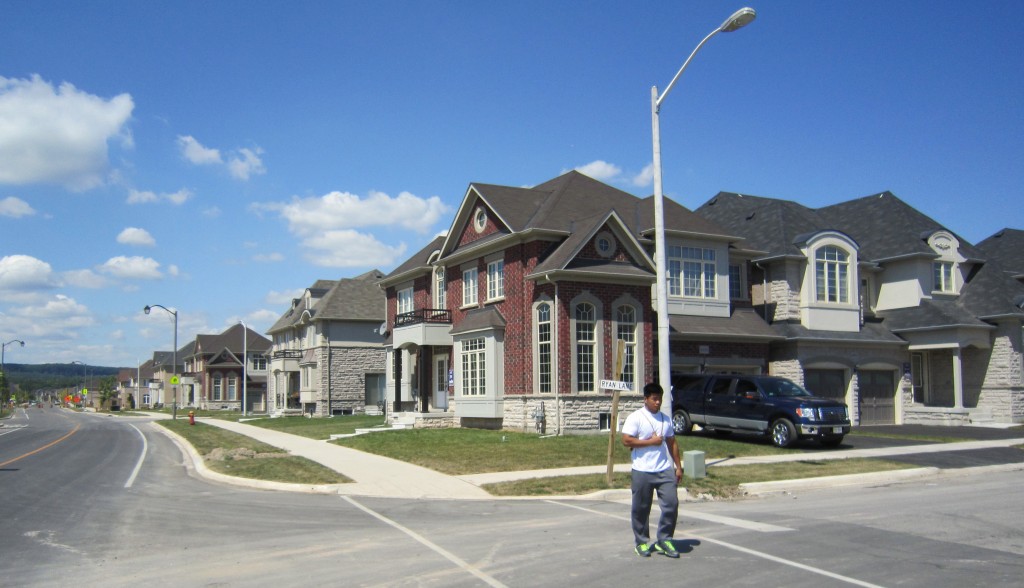 Alton Village The bulk of municipal land zoned for housing – at least two-thirds of it in many cities – is reserved for detached homes, while multiunit housing is restricted to small designated areas, generally in the city core but often far beyond or on abandoned industrial lands. That leaves the supply of housing artificially limited, particularly in areas near transit lines and city centres.
Meanwhile, owners of detached homes, who have the ear of elected officials, argue the so-called character of their neighbourhoods must not be disturbed. The long-standing status quo serves them well, effectively enriching them through government policy.
But the argument about character is a smokescreen. Where there is a neighbourhood of single-family homes, there was once a forest or a field. No one mourns the lost character of what had been there before. Character is wielded as a weapon against change. As Globe and Mail architecture critic Alex Bozikovic put it in June, “’Character’ means exclusion.”
There is an answer. It’s called the missing middle: small-scale, multiunit housing, from duplexes and triplexes to mid-rise apartment buildings. The missing middle is not a fix-all, but it is an essential step forward.
Minneapolis is a beacon of possible change. Last December, city council passed a plan that ended the dominion of single-family zoning. It is regarded as the first of its kind in the United States, but it’s hardly radical. Where a single house was previously permitted, a building with three units, a triplex, is now allowed. The rallying cry has been “Neighbors for More Neighbors.”
Oregon was the next to move. State legislators in late June passed a bill that will remake single-family zoning to allow fourplexes in cities of more than 25,000 people, and throughout the Portland region.
In Canada, the prospect of change is depressingly dim. In the City of Vancouver, a one-year trial allows applications for duplexes in single-detached zones. This is in a region where the typical house costs $1.4-million and median annual household income is $73,000. Meanwhile, city council is ponderously debating whether to get work started on a new citywide plan that will take three years to complete.
This is the opposite of urgency.
In Toronto, the story isn’t much better. The province in June approved new rules for downtown and midtown Toronto, after reworking plans the city had submitted, but the geographic reach of change is limited. There is no serious talk of rezoning what’s dubbed the “yellow belt” – the 70 per cent of available land limited to single-family homes.
The moves in Minneapolis and Oregon are interesting, but modest compared with what is needed in Vancouver and Toronto. Small apartment buildings – of three, four or five storeys – would go a long way. Then there are important questions about low-income housing and rental housing. And there’s the issue of how cities should benefit from increases in land values sparked by zoning changes.
But first we need some political will. There are 10 million Canadians between the ages of 20 to 40, the time of life when people make a first foray into home ownership. Canada’s zoning rules are antiquated. They should be rewritten to serve the present, not the past.

 By Pepper Parr By Pepper Parr
June 12th, 2019
BURLINGTON, ON
At a few minutes before 4:00 pm yesterday afternoon Council adjourned and will meet again on the 15th to approve (or not approve) all the reports that were debated.
It has been a mammoth session for this crowd.
On Monday they went from 9:30 am to 10 pm
On Tuesday they went from 9:30 am to 10 pm
On Wednesday they went from 12:30 to 10 pm (the forenoon was spent at a Regional Council meeting
On Thursday they convened at 12:30 and adjourned at 4:00 pm
In June Council revised their working schedule and had Standing Committee meetings start at 9:30 am instead of the standard 1:00 pm start.
The work load and the amount of time to read, think about the reports, discuss them with constituents and then stay at a desk for those lengths of time is going above and beyond.
This is a determined bunch of people – Mayor Meed Ward is right in her element – she is just loving it. Others however, are wondering if this is the best way to run a municipal government.
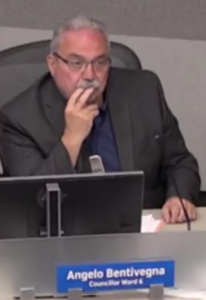 Bentivegna – “Agenda just keeps getting bigger and bigger and bigger.” Ward 6 Councillor Angelo Bentivegna said that the agendas are “getting bigger and bigger and bigger” and keeping up is a challenge for both Bentivegna and several others.
We are seeing some quality work being done and we are also seeing some shifting as to where the decision making is actually being done.
City manager Tim Commisso has adopted a style that has him commenting on a matter rather than leading the discussion.
When council was in the process of determining what they needed in the way of a city manager the Gazette suggested someone with depth and experience who wasn’t necessarily going to be around for ten years or, someone younger who was ready for the kind of challenge Burlington is and could put in the time to rebuild the ranks and develop a different culture.
Commisso – doesn’t say much, tends to lean into his chair and listen. Doesn’t pick up his cell phone that often and rarely speaks at any length. The only time the Gazette saw him fussed at all was when it looked as if council was going to empty all the cookie jars (known as reserve funds) and leave him and the Treasurer to figure out what to do when there was a real crisis.
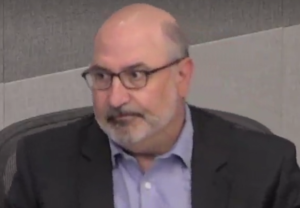 The Commisso stare. Our view of Commisso’ s approach is not intended to suggest he is slack or not paying attention. When he becomes aware that a staffer is not really answering the questions adequately they get what can only be called ‘the Commisso stare’. At one point he chose to lean forward and point to a document to direct the staffer – who we understand might be leaving the position he holds.
Commisso is fully engaged – but he is not immersed the way former city managers tended to behave. He is prudent – he will spend when he has to but he doesn’t reach for the wallet all that quickly.
Too early to tell, but he likes the people he is leading, and make no mistake, Commisso is leading. He serves at the will of council and this council is very happy to have him lead them – certainly at this stage of their political careers.
The round of Standing Committee meetings this council just completed some vitally important recommendations that will go to council Monday evening.
The downside to all this is that there is not much time for the public to be aware of what was done and then time to reflect and discuss with their neighbours what is being recommended. The agenda itself is five pages long.
This approach is not what one would describe as “fully engaging the public”. Given the recommendations coming forward there is no obvious reason why the council meeting could not have been held on the 22nd or the 29th. We asked the Office of the Mayor for comment – our contact is away until Monday.
Are they that anxious to get started on their vacations? which by the way they deserve, but let’s complete the work and then start the vacations.
 Salt with Pepper is the musings, reflections and opinions of the publisher of the Burlington Gazette, an online newspaper that was formed in 2010 and is a member of the National Newsmedia Council. Salt with Pepper is the musings, reflections and opinions of the publisher of the Burlington Gazette, an online newspaper that was formed in 2010 and is a member of the National Newsmedia Council.

 By Pepper Parr By Pepper Parr
July 2nd, 2019
BURLINGTON, ON
The Gazette got a note from a reader alerting us to plans on the part of Mayor Marianne Meed Ward to advocate for the abolishing of the Local Planning Act Tribunal (LPAT), formerly the Ontario Municipal Board.
Meed Ward is part of the Large Urban Mayor’s Caucus of Ontario and is reported to be in talks with her colleagues there on bringing something forward. The Gazette is advised that: “To date, no motion has come before a Burlington committee or council.”
The Mayor’s office did say that she had “released a statement regarding the passing of the Province’s Bill 108 where she references her feelings towards the old Ontario Municipal Board (OMB) rules being reinstated under LPAT.
We asked a number of people what they thought of the move to lead the cry for the end of LPAT – got this from someone who has experienced with the Mayor who said: “MMW is putting herself in the front ranks of the Ford antagonists. We’ll see where that takes her and for how long.”
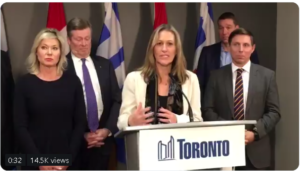 Expect to see more of our Mayor traveling in different circles. Two things are happening. The Mayor would like to see an end to provincial involvement in municipal matters; she is in the process of building a profile beyond the boundaries of the city.
The breakout year for the Mayor will be 2026 or 2027. You heard it here first.
Stay tuned.

 By Staff By Staff
June 29th, 2019
BURLINGTON, ON
The good folks at We Love Burlington make a very strong point when they take the remarks Premier Doug Ford made about the way local communities choose who is going to represent and protect their interests.
 Doug Ford: “Less politicians is a good thing. More politicians, it’s a bad thing.” He then increases the size of Cabinet to the largest Ontario has ever had. When asked about the potential for regional amalgamation Ford explained that “What we’re trying to do is reduce the size and cost of government right across Ontario.” He continued by asserting that “Less politicians is a good thing. More politicians, it’s a bad thing.”
The We Love folks say they could not agree more. So why, they ask, has the Premier increased the size of his cabinet to one of the largest in Ontario history? There are now more Parliamentary Assistants and more Ministers than Toronto has City Councillors.
Fewer politicians for cities but more power for the province? The We Love people fear our local voices being lost.They also note that neither of Burlington’s MPPs were given the opportunity to take on bigger challenges; no promotions for the local political talent.
There is a nugget of information in there somewhere.
 We Love Burlington is a collection of people who came together to protest plans to amalgamate Oakville, Milton, Burlington and Halton Hills into one administrative organization. We Love Burlington is a collection of people who came together to protest plans to amalgamate Oakville, Milton, Burlington and Halton Hills into one administrative organization.

 By Pepper Parr By Pepper Parr
June 28th, 2019
BURLINGTON, ON
Monday morning, Canada Day, all seven members of city council are going to start their day at 8:30 am for what one member called a “full court press”. Everyone has something they are expected to cover said one member of Council.
 At this point this Council is working as a group. Several describe the Mayor as “very political” but they appear to be comfortable with her approach. At this point this Council is working as a group. Several describe the Mayor as “very political” but they appear to be comfortable with her approach.
Five of the seven are still getting their footing. We are seeing the strengths in some and the difficulty others are having getting a grip on the job they have.
 It was the highlight of their lives – the challenge is for them to make a real difference. They now have a city manager that they are all more than content with.
When you look at the comments they place on their Facebook pages – they are identical – word for word. Almost as if someone directed them what to say.
They are working quite well as a team but are still working out some of the plays. What we are not seeing is the rancour and the dismissiveness that was so prevalent in the previous council.
Time for a closer look at the individual council members and their performances. After the holidays.
–

 By Ray Rivers By Ray Rivers
June 26th, 2019
BURLINGTON, ON
“In the end, Trudeau’s Carbon Tax takes money out of your pockets and puts it into the government’s coffers.” (Andrew Scheer – ‘A Real Plan’ – June 19, 2019)
It is disappointing to see a major political leader be so disingenuous. An error of omission? No it is a deliberate deception because he must know that the money from the federal carbon tax mostly ends up in people’s pockets, not the government coffers. The federal carbon tax is as revenue neutral as it gets.
 Andrew Scheer; Leader of the Opposition. And Andrew Scheer’s new “A Real Plan” is best described as taking Canada back to business as it used to be under former PM Stephen Harper. Indeed there are some decent ideas in the document. Still it is pretty much yesterday, highly partisan and was clearly intended for use during the upcoming federal election.
Climate change is only one part of the plan and there is speculation that this vague plan might even lead to an increase in greenhouse gas (GHG) emissions, rather than reductions. So it is comforting to see that Scheer has at least endorsed the current federal 30% emissions reduction target, which was originally penned by his former leader, Stephen Harper.
Scheer, in his preamble to his plan notes the contributions of previous Conservative governments to the environment. Though it is confusing to see Mr. Harper given credit for net declines of greenhouse gas emissions between 2007 and 2015. After all Ontario’s Doug Ford, who wasn’t even in office then, is claiming the rest of Canada has gone up by 3% since 2005 while Ontario fell by an impressive 22%. And that was because of McGuinty and Wynne, not Harper.
Scheer, along with those provincial Conservative premiers who now populate most provinces in the country, have shunned market based solutions (carbon taxation) and the role of individuals in fighting climate change. Instead they are looking to industry to do the heavy lifting by inventing and implementing some kind of green technology – which will magically reduce emissions.
The Conservatives have also dusted off an old Chretien Liberal homeowner energy saving program, cancelled by Harper. And there are subsidies and tax holidays and reductions promised, but no roadmap as to how all of these pieces will come together to meet Canada’s emissions target.
 Andrew Scheer Scheer has also suggested Canada might partly meet its emissions target by exporting natural gas to developing nations which are currently burning coal, although it is not clear that will be allowed under the Paris Agreement. And didn’t Mr. Harper scoff every time the Chretien Liberals raised the idea of international emissions credits in connection with the Kyoto Protocol?
Will tinkering around the edges be enough? Shouldn’t we be considering what gets produced in addition to how things are produced? For example, what about the necessary shift from petroleum to electric vehicles (EV)? With no carbon tax and no EV rebate how does Scheer motivate people to make the transition to more environmentally friendly transport? That is huge hole in his plan.
Carbon is intrinsic to fossil fuels. The only way to avoid GHG emissions from it is to avoid using the fossil fuels. Ultimately the petroleum industry will need to wind up operations and just plain shut down for the good of the planet. Finance Minister Morneau said as much, speaking frankly to industry captains at the Economic Club in Calgary just days after the Trudeau government had approved completion of the Trans Mountain pipeline.
Now that takes guts. But not Andrew Scheer. He was elected from Saskatchewan and winding down the energy sector is not in his cards or part of his philosophy. But maybe he doesn’t get it or doesn’t want to get it. Maybe Kim Campbell had a point in her remarks about how some people still see the climate issue.
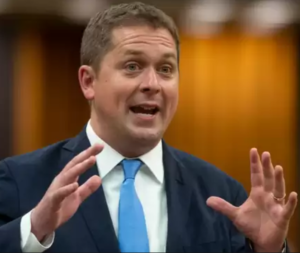 Andrew Scheer Only days earlier, just ahead of the Trans Mountain announcement in fact, Parliament passed a motion declaring that Canada was facing a national climate emergency. This was inspired by the recent report that Canada is warming at twice the rate of the rest of the world. And to bring the point home over 40 of Canada’s top scientists had projected Canadians will end up with 10 times as many deadly heat waves and twice as many extreme rainstorms.
Of course that was the day of the Raptors big party in Toronto, so Elizabeth May was the only party leader in the House. But still, the motion passed by a three to one majority, though Mr. Bernier’s People’s Party and the Conservatives voted against it. And that probably says all we need to know about Mr. Scheer and his ‘A Real Plan’.
But don’t take my word, just ask former PM Kim Campbell.
 Ray Rivers writes regularly on both federal and provincial politics, applying his more than 25 years as a federal bureaucrat to his thinking. Rivers was once a candidate for provincial office in Burlington. He was the founder of the Burlington citizen committee on sustainability at a time when climate warming was a hotly debated subject. Ray has a post graduate degree in economics that he earned at the University of Ottawa. Tweet @rayzrivers Ray Rivers writes regularly on both federal and provincial politics, applying his more than 25 years as a federal bureaucrat to his thinking. Rivers was once a candidate for provincial office in Burlington. He was the founder of the Burlington citizen committee on sustainability at a time when climate warming was a hotly debated subject. Ray has a post graduate degree in economics that he earned at the University of Ottawa. Tweet @rayzrivers
Background links:
A Real Plan – A Perspective – Increase Emission –
More Real Plan – Morneau – Climate Change Emergency
Doug Ford’s Claim – Kim Campbell –

 By David Barker By David Barker
June 23rd, 2019
BURLINGTON, ON
Ms McKenna in your statement directed towards the We Love Burlington group, published in the Burlington Gazette, you state “Our estimates from the Ministry of the Attorney General show that over 100,000 housing units are caught up in legacy cases at the tribunal.
That’s 100,000 desperately needed homes that can’t get built – or three years worth of construction in Ontario waiting for approval….” By making this statement, Ms McKenna, you imply that you would expect all 100,000 units that await review by LPAT would gain its approval.
Maybe you did not mean to imply that. But your statement reflects exactly the public’s perception of just what is wrong with LPAT (and before it OMB). The perception is that the unelected, unrepresentative body seems to invariably side with the developer’s position, completely ignoring the municipality’s official plan and the desires of the local residents.
Please can you provide any justification as to why the Province of Ontario should even have an unelected, unrepresentative body to pass judgement on how a municipality manages it’s development. As far as I am aware no other Canadian Province has such a body. I assume in those other Provinces the developer’s recourse is to a non-political court system. Should that not also be the recourse here in Ontario.
Surely if a municipality has an official plan that has been accepted and approved by it’s region (and by implication the Province) why should that municipality then be second guessed by an unelected, unrepresentative political body. If a developer’s proposal does not comply with the requirements of the municipality’s (Region/ Province approved) official plan, then surely the developer should not expect municipal plan approval until it does conform.
My understanding is the official plan in effect in Burlington dates back to 2008. That means the official plan has been in effect for ten years NOT twenty five years as you contend. That 2008 official plan, although soon to be superceded by an updated official plan, does in fact remain compliant with regional and Provincial requirements. As such it should be respected by all, including developers, the Province and LPAT.
Ms McKenna you are right to champion the need to increase the supply of affordable housing, both rental and owned. I believe you will find allies fir that goal at the Region, at Burlington City Council and in the community. However, the high rise condo developments proposed for downtown Burlington do not in any meaningful way address affordable housing. The price point of the proposed condos are way outside the affordability of first time home buyers. Further the monthly rental cost of those units being bought by investors for the rental market is also likely to be well beyond the budgets of the twenty something’s who look for affordable rental accommodation. So for you, Ms McKenna, to in any way imply that the developers proposals for downtown Burlington high rises address affordable housing is completely disingenuous on your part.
Please, Ms McKenna would you temper your standing up and defending the bullying Ford government, of which you are a part, with more standing up and advocating for the desires and positions of your constituents who elected you to represent them. Those views are clearly and accurately expressed and advocated by the City of Burlington Council.
I dare you to publish on your website this opposing view to your statement. But I doubt you are either brave enough or confident enough to do that.
David Barker is a Burlington resident who lives on Lakeshore Road.

 By Staff By Staff
June 21st, 2019
BURLINGTON, ON
We Love Burlington asked the MPP for Burlington to respond to their request for her views on Bill 108 and the impact it was going to have on the city.
The MPP responded.
We Love Burlington took issue with what the MPP said and sent her their comments which appear below in red.
Jane McKenna’s letter is in black, the We Love response is in red.
 Burlington MPP Jane McKenna I want to clarify some of the issues you have raised in your submission on Bill 108. Your underlying assumption appears to suggest the province is trying to curtail local planning authority rather than ensure the best planning outcomes. Nothing could be further from the truth. I want to be clear that the Ontario government wants to improve the local planning process to facilitate better and faster community consultation, a more open community benefits strategy that requires more local input and ensures that growth pays for growth.
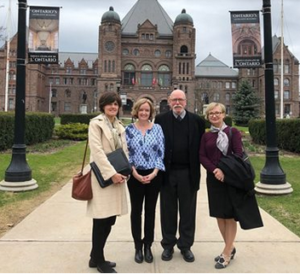 Part of the We Love team outside Queen’s Park: From the left Deborah Ruse, Lynn Crosby, Blair Smith and Josie Wagstaff Bill 108 definitely curtails local planning authority. Setting shorter timelines for the review of development applications directly impacts the ability of municipal planning staff to deal with the comprehensive nature of applications, consult with the public, or seek collaboration with applicants. Instead of allowing for the community and parties to work together, shortened timelines will increase adversity. These are impractical timelines for staff and municipal councils for even the most simple, straightforward applications. The result will be even more appeals for non-decisions, thereby defeating the desire to increase housing faster.
While the LPAT remains, it will no longer evaluate appeals based on compliance with official plans and consistency with provincial plans/policies. Bill 108 returns it to the more adversarial OMB process and, as such, a return to de novo hearings. This is very disappointing for residents and municipal governments, as it takes final planning decisions out of elected councils’ hands. Historically, the use of a de novo approach to appeals has resulted in drawn out hearings, lags in decisions and a backlog of cases. The return to this process has no positive effect to speed up housing development. This aspect of Bill 108 has been characterized as a return to the substance (if not the fact) of the former Ontario Municipal Review Board. We agree and consider it a fundamental flaw of the proposed legislation.
Your submission on Bill 108 and our new Affordable Housing Supply plan was one of the more than 2,000 public submissions that were considered prior to drafting the plan and supporting legislation.
We never made a submission – you’ve cut and pasted inaccurately.
Despite your claims to the contrary, extensive consultations, in which you participated, took place in the development of the More Homes, More Choice Act, 2019. Within months of the June election, Municipal Affairs and Housing Minister Steve Clark began consultations in the development of the Ontario government’s new Housing Supply Action Plan.
We were never consulted nor did we ever participate – sorry, wrong again. Indeed, the whole presumption of consultation with a piece of legislation that was rushed through in one month is rather interesting.
Perhaps you would like to elaborate?
Minister Clark met with local Mayors at the Association of Ontario Municipalities, (AMO) conference last August in Ottawa and at the Large Urban Mayor’s Caucus of Ontario, (LUMCO) last month in Toronto. In fact, at the recent LUMCO meeting, the Minister advised that if Bill 108 passed, the Ministry would be consulting further on the Community Benefits Formula. Last week, the Minister sent a follow-up letter to all heads of Municipal Council in advance of a June 14th meeting with AMO members.
Oh, should we be passing your response to Mayor Meed Ward? This seems to be intended for her.
Many organizations including the Centre for Urban Research and Land Development at Ryerson University have published research demonstrating that one of the key roadblocks to building an appropriate mix of housing in the GTHA that supports vibrant, walkable, complete communities is the land-use planning approvals process. In the City of Toronto, by way of extreme example, it takes on average 10 years to get a building approval. This is a system that has been mired in excessive red tape, with regulations and processes added to processes. These were often attempts to satisfy and balance the adversarial needs of the development community and neighbourhoods that are often resistant to change. Add local politics and politicians who do not vote against their constituents’ wishes in support of good planning (that has proven to be unpopular) and you have a recipe for paralysis.
· So, to paraphrase – re-instituting the OMB and de novo hearings, which were the subject of the research referenced above, will improve the land-use planning process.
· Neighbourhoods are subject to “nimbyism.”
· Local politicians who listen to their constituents are somehow flawed; the province knows best.
Really?
How are we to meet our responsibility to solve the very serious housing crisis that is preventing our children from being able to afford to rent or own in their home town? How are we to manage the influx of more than a million newcomers to the GTHA by 2031 if not by encouraging the private and non-profit sectors from building a variety of new housing supply through legislation?
With the cost of the homes and condos that developers put on the market “our children” will never be able to own their own accommodation. ‘More homes’ does not mean ‘more affordable homes’ – this is a simplistic assumption.
Municipalities plan for housing and are required to keep a 10 year supply of land designated for growth and a 3 year supply of draft and registered housing – that means housing ready to be built. Developers taking OPs to the OMB created, on average, a three year delay. There is no doubt we need more low-income subsidized housing than is currently available, especially in the GTA, but there is no shortage of unaffordable, single family homes.
You complain that Burlington has lost control of land use planning. You are correct. Here’s why.
Burlington City Council has not produced an updated Official Plan in about 25 years – since 1994. One could suggest a variety of reasons for this. More recently, as development pressures have increased, politics have no doubt played a role.
We believe that the current OP dates to 2008 – not 1994.
When the planning system is clunky, expensive, time consuming, outdated and adversarial it’s time for process adjustment.
And that’s why you brought back the most adversarial of processes and adjudication forums, the OMB, in spirit if not in fact?
The Province’s Growth Plan is guided by the desire to build compact, vibrant and complete communities. It does not replace local official plans, but it does provide a framework for growth that requires municipalities to update their Official Plans to ensure compliance with the Places to Grow Act. Oakville updated their Official Plan in 2009 to conform, and Milton amended their 1997 Official Plan in 2010 to meet these provincial policy changes.
Burlington’s 2008 OP was judged to be consistent with the Places to Grow Act and the 2014 Provincial Policy Statement.
Burlington’s 25-year-old Official Plan doesn’t respond effectively to the growth pressures of 2019. An outdated Official Plan does not work for our communities, our children who would like to be able to afford a home in town, our investment community or our new residents. Our OP reflects a time when Burlington was 50,000 people smaller, back when the average price of a detached house was about $200,000.
The current and approved OP dates to 2008 and is not 25 years old.
Our Official Plan doesn’t take into account the most significant changes to planning policies in Ontario’s history. That is a big part of why, more often than not, Burlington has surrendered local planning decisions to both the old OMB and new current LPAT. To take back some local control, Burlington needs to act quickly to consult with residents and adopt a new Official Plan that complies with the Places to Grow Act and will be approved by Halton Region.
Burlington’s “adopted” OP, that was hastily pushed through the previous administration in order to comply with the Places to Grow Act, has been judged to be non-compliant by Halton Region. The 2008 OP, which is the approved OP, is compliant.
Municipal governments are expected to be accountable and adaptable to legislative and regulatory changes. Change only becomes dysfunctional when it is not effectively managed. We believe that assessing and planning for operational and financial impacts is within the capability of the City of Burlington. The municipality will decide whether to raise taxes, reduce services or increase borrowing for capital expenditures as necessary.
So, you’re saying that the operational and financial impacts of Bill 108 will, indeed, force Burlington to “raise taxes, reduce services or [borrow] for capital expenditures”. Thank you for your honest evaluation.
We have a housing supply crisis in Ontario that is being addressed by More Homes More Choice. Our role as government is to create the conditions where home builders can build more of what communities actually need. Our plan includes changes that would make it easier to build a mix of housing – townhomes, apartments, condos, single family homes – for people to rent or own. You are incorrect when you write that developers can build whatever, wherever they want.
Bill 108 is being called the “Developers Dream Bill” as the Ontario Home Builders Association got almost everything they asked for. The Bill enacts changes to legislation that implement the provincial Housing Action Plan. Overall it makes it easier to build housing anywhere in the province. The new Growth Plan, A Place to Grow came into effect May 16th, 2019. It permits expansions of settlement boundaries (up to 40 ha- 100 acres at a time) and conversions of employment land ahead of an MCR- Official Plan review. It is reasonable, therefore, to expect more sprawl onto farmland.
The GTHA – Burlington included – is the fastest growing region in Ontario and one of the fastest growing metropolitan areas in North America. Good planning is vital to creating strong healthy communities for our kids and our grandkids.
Agreed but Bill 108 is not “good planning”. We agree to disagree here.
As part of Bill 108, changes were made to the Planning Act to simplify how municipalities collect funds for community benefits like parks and daycares. Minister Clark has been clear that one of our goals in establishing the new community benefits approach is to maintain municipal revenues and ensure appropriate infrastructure to support growth. We want municipalities to recover similar revenues from community benefits charges to what they have collected from development charges for discounted services, density bonusing and parkland dedication. We will develop a cap that protects vital revenue streams.
You have simply made it more difficult for municipalities to collect funds for community infrastructure, since they are no longer eligible for inclusion in development charges, and far less likely that such infrastructure will be well funded.
Let me be clear – the provincial government firmly believes that growth should pay for growth. In passing Bill 108, we are moving towards a system where developers, not taxpayers, fund growth.
Well, your statement is “clear” but not accurate. This is simply not the case. The amendments to the collection of development charges means that taxpayers will be liable for a whole range of community infrastructure costs that were previously included in the development charges.
It is important that municipalities have the resources to support complete communities and give the public the opportunity to provide input through public consultation. This does not happen in todays Section 37 negotiations.
Agreed. But where is the locus of the final decision? Is the public merely consulted or does it have a decisive voice? Unempowered consultation produces cynicism and little else.
In April 2018, Burlington’s Mayor said that, (under the pre-Bill 108 system) “residents don’t have a seat at the table when negotiating Section 37 Community Benefits. The Ward councilor is consulted, but also doesn’t have a seat at the table, and their input can be ignored.”
Our government agrees that Section 37 was not serving the best interests of local residents. That’s why we are working to ensure there is more public input into community benefits decisions through a municipality wide community benefits strategy.
And where is that Mayor now? It was possible to implement a different protocol for Section 37 and have a more open process for the determination of community benefits. The previous council chose not to do so. The previous council no longer exists.
Again, let me be clear – we are not removing any community protections. Our government will continue to consult with our municipal partners on the development of a community benefits charge that takes the politics out of planning.
And may we be “clear”. It is hubris of the highest nature to say that a provincially mandated process that severely limits municipal powers/funding and is implemented with no or little municipal consultation “takes the politics out of planning”.
A long-standing tenet of land use in Ontario, as established by the province and undertaken by municipalities, is for the building of complete communities – places where homes, jobs, schools, community services, parks and recreation facilities are easily accessible. As intensification and vertical housing become more prevalent, particularly in cities such as Burlington that are targeted for intensification, access becomes even more important.
For decades, the province has allowed municipalities to require parkland based on number of units being built, creating a direct relationship to the number of people living in a new development. If cities choose to keep a limited version of the parkland dedication by-law, they lose the ability to collect land or cash based on units built and are limited to require 5% of the land area of the new development. A 5% requirement on a small site being used for a high-rise development does not deliver a “park” space for residents that will contribute to livability in any manner. Our parks are critical pieces of infrastructure that not only help to alleviate the effects of global heating but also play a pivotal role in creating places where people actually want to live. Further, Bill 108 compels cities to spend 60% of the money they collect each year, thus making it harder for cities to save up funds for larger park projects and land purchases.
Not only does Bill 108 severely curtail the ability for cities to require developers to provide parkland onsite, it also removes the ability for those same cities to use development charges to collect money for parks and other soft infrastructure. The proposed new development charges amalgamate many of the tools cities have used for things such as affordable housing and turned them into either/or situations. These restrictions are exacerbated by a yet-to-be identified cap the government will announce at a later date.
Our plan also includes changes to the Local Planning Appeal Tribunal (LPAT) – formerly the Ontario Municipal Board – and the main adjudicator of land use planning disputes in Ontario. Right now, the tribunal has a backlog of legacy cases from the old Ontario Municipal Board. A two-to-three year appeals process, at a time when Ontario is in a housing crisis – is unacceptable.
Agreed, so why did Bill 108 essentially end the LPAT experiment, virtually before it even began, and reinstitute the spirit, if not the fact, of the OMB?
Our estimates from the Ministry of the Attorney General show that over 100,000 housing units are caught up in legacy cases at the tribunal. That’s 100,000 desperately needed homes that can’t get built – or three years worth of construction in Ontario waiting for approval.
Thanks to the Attorney General’s support, we are also adding 11 new adjudicators, a 45% increase, to tackle the backlog of cases in the next 18 months and prevent future backlogs.
We’re encouraging mediation to reduce the number of cases that actually proceed to a formal hearing and we are moving towards a cost-recovery model where developers will pay more for the system.
On the Endangered Species Act, our legislation takes a smarter approach to recover species, including new methods for protecting species at risk due to disease, fungi or invasive species.
It is difficult to understand the “wisdom” to the proposed approach given the provisions and impacts of Bill 108, specifically;
· Delay in listing species at risk from the current 3 months (from submission of assessment report) to 12 months during which time the species and their habitat are unprotected.
· Increased Ministerial discretion to second-guess assessments and/or delay recovery strategies and protection
· Requirement that assessments not be based on the status of the species in Ontario but on its geographic range, a much broader application
· Decoupling of the listing of endangered species and their habitats from automatic protections
· Provision of far greater ministerial discretion
· Delay in the application of automatic protections for newly listed species for one year – for existing permit holders
· Ministerial discretion in limiting protections to specific geographies or circumstances
· Ministerial discretion to delay indefinitely the development of Government Response Statements
· Removal of the requirement to post notices on the Environmental Bill of Rights Registry under specific circumstances
· Ministerial discretion to delay reviewing progress towards the protection and recovery of species
On the contrary, it would seem that “smarter” is simply “less stringent”.
Currently, after an applicant looks at alternatives to avoid a species at risk and mitigates any risk their project may have on that species, they are required to develop a plan to benefit the species through actions like habitat creation. However, some species like the Butternut Tree and several bats are decreasing due to factors harder to control or mitigate such as disease, and invasive species.
The current Act doesn’t allow the most effective path to resolve these issues. Our changes will allow applicants who have considered alternatives and put in place mitigation measures to pay a charge to the Species At Risk Conservation Trust instead of completing other onerous requirements, such as expensive field surveys that could cost $30K per species.
This will help enable positive outcomes for species that are decreasing due to disease, invasive species or other reasons by accumulating payments and leveraging the collective resources for more strategic, coordinated and larger scale actions.
“Pay to Slay” – what a grotesque feature of Bill 108.
Bill 108 creates a regulatory ‘open season’ for endangered species by:
· Allowing proponents of harmful activities to pay into a fund in lieu of fulfilling on-the-ground requirements that would otherwise be imposed under the ESA
· Removing the requirement for the Minister to consult with an independent expert and obtain Cabinet approval prior to issuing permits for harmful activities
· Removing the requirement for the Minister to consult with an independent expert regarding the potential impact of a regulation on species at risk
· Creating “landscape agreements” for proponents undertaking multiple harmful activities throughout a geographic area.
· Removing the current requirement to provide an overall benefit to negatively impacted species when harmful activities approved under other pieces of legislation are authorized to proceed under Section 18 of the ESA.
“Accumulating payments and leveraging the collective resources for more strategic, coordinated and larger scale actions” is political-speak for increased government and increased bureaucracy with little if any of the accumulated funds being used to benefit the actual endangered species.
Ontario is committed to ensuring Ontario’s best-in-class endangered and threatened species protections include advice and species’ classifications from an independent scientific committee and modern approaches to enforcement and compliance; species and habitat protections; and recovery planning.
But it removes the requirement for the Minister to confer with field experts. It creates a “committee” and one that doesn’t necessarily need to be completely composed of scientists with relevant field expertise. This is a patently bureaucratic response that significantly weakens existing protections. We congratulate you!
During the past decade of implementing the ESA, we have heard what works well and what could work better.
The proposed changes posted on the Environmental Registry will enhance government oversight and enforcement powers to ensure compliance with the act and improve transparent notification of new species’ listings.
Given the actual regulatory amendments to the ESA that Bill 108 implements and their impact, it is difficult to understand how this statement could be made with ‘a straight face’.
Species assessment and classification decisions will continue to be made by an independent scientific committee – the Committee on the Status of Species at Risk in Ontario (COSSARO). The list of species at risk will continue to be updated automatically, based on the independent science-based assessment process.
Ontario is also proposing to create Canada’s first independent agency to be called the Species at Risk Conservation Trust, to allow municipalities or other applicants the option to pay a charge to the Agency in lieu of completing certain on-the-ground activities required by the act.
This is the typical bureaucratic response; to either create a committee or an organization – when in doubt increase the bureaucratic footprint. This particular agency should and could be called “The Pay to Slay Trust”. In this grotesque instance, you get to pay a “bounty” that circumvents the protective requirements of the ESA.
Applicants would still seek a permit and need to fulfill on-the-ground requirements, including considering reasonable alternatives for their activity and taking steps to minimize the adverse effects of the activity on the species at risk.
Bill 108 is important legislation to solve one of the most pressing and urgent problems of our time – a shortage of housing stock has driven prices up making homes unaffordable for many families. With on going global urbanization Burlington, as part of the GTHA, is experiencing extraordinary development pressure as more and more young people want to live and raise their families here. We can’t stop growth but we can manage it successfully with intention and good planning.
There are few young families that can afford the housing prices in Burlington. What is being created by intensification and mindless core development, is a transient community of nomads that alight in a particular locale for a short period then move on – no roots, no commitment, no community.
This is a municipal responsibility. We all love Burlington. We can watch it transform into the kind of community we want – one with a vibrant downtown, with plenty of families and couples walking and cycling to pick up fresh groceries or to meet some friends at a café. The air will be cleaner because we will be driving less, we will be healthier because we’re walking and cycling more.
With all due respect, this is meaningless pap.
This is a long term vision. We need to extend our view 20, 30, 40 years into the future. The next generation of mobile young people are looking to live, work and play at home.
The wonderful thing about “long term” visions is that no one is around to validate their accuracy. Indeed, the halls of Queen’s Park are carpeted with the “long term” visions of previous governments. We thought that this government, “of the people”, was committed to immediate action and redress in order to secure our future. We thank you for returning us to the accustomed and the norm.
This is legislation that is important and integral to our well being and success as a community. We have much to celebrate and I welcome divergent views and thoughtful criticism.
Leadership and dialogue would be the most advantageous approach for the municipality and the provincial government. The people of Burlington deserve no less than our honest commitment to do the hard work necessary to solve the housing crisis in the GTHA and beyond.
With all due respect (again), this is empty and rather bland rhetoric. The people of Burlington deserve honest representation and a commitment to their best interests above those of political allegiance.
The Gazette will ask the Office of the Mayor for her take on the remarks the MPP makes about the city’s Official Plan.

|
|
 Barker, a Lakeshore Road resident, takes issue with Jane McKenna’s position on affordable housing. She basically sticks as close as possible to the Ford government position- something Jane has always done. She knew the lines to the Tim Hudak position on significant issues better than Tim Hudak did when he was PC party leader.
Barker, a Lakeshore Road resident, takes issue with Jane McKenna’s position on affordable housing. She basically sticks as close as possible to the Ford government position- something Jane has always done. She knew the lines to the Tim Hudak position on significant issues better than Tim Hudak did when he was PC party leader. Will you be offering your thoughts or comments as to those suggestions:-
Will you be offering your thoughts or comments as to those suggestions:-





































 Since TechPlace launched in 2017 it has hosted over 10,000 visitors, 200 events, attracted 13 LaunchPad companies, creating a strong business attraction brand and value proposition for Burlington. Results since inception are:
Since TechPlace launched in 2017 it has hosted over 10,000 visitors, 200 events, attracted 13 LaunchPad companies, creating a strong business attraction brand and value proposition for Burlington. Results since inception are:











 The new Canada Food Guide is a science-based document which has been extensively researched and was crafted following wide ranging consultations across our society. It has taken a decade for the officials responsible to muster the courage to come forward, break with tradition, and tell it like it is. The guide is signalling that it’s time to cut back on meat and milk and salt and sugar… and fast food.
The new Canada Food Guide is a science-based document which has been extensively researched and was crafted following wide ranging consultations across our society. It has taken a decade for the officials responsible to muster the courage to come forward, break with tradition, and tell it like it is. The guide is signalling that it’s time to cut back on meat and milk and salt and sugar… and fast food.



 These impertinent letters each contain eight questions covering: economic competitiveness; skills training; immigration; healthcare; climate change; the Arctic; indigenous reconciliation; and federalism. Interestingly Maxime Bernier and his People’s Party didn’t get a letter. Was that an oversight or because a vote for Bernier would end up as a vote for the centre-left parties?
These impertinent letters each contain eight questions covering: economic competitiveness; skills training; immigration; healthcare; climate change; the Arctic; indigenous reconciliation; and federalism. Interestingly Maxime Bernier and his People’s Party didn’t get a letter. Was that an oversight or because a vote for Bernier would end up as a vote for the centre-left parties?



 The defining feature of North American cities is the single-family detached home. It is the least efficient way to house people, yet municipal zoning laws have historically served to ensure its primacy.
The defining feature of North American cities is the single-family detached home. It is the least efficient way to house people, yet municipal zoning laws have historically served to ensure its primacy.


 Salt with Pepper is the musings, reflections and opinions of the publisher of the Burlington Gazette, an online newspaper that was formed in 2010 and is a member of the National Newsmedia Council.
Salt with Pepper is the musings, reflections and opinions of the publisher of the Burlington Gazette, an online newspaper that was formed in 2010 and is a member of the National Newsmedia Council.



 We Love Burlington is a collection of people who came together to protest plans to amalgamate Oakville, Milton, Burlington and Halton Hills into one administrative organization.
We Love Burlington is a collection of people who came together to protest plans to amalgamate Oakville, Milton, Burlington and Halton Hills into one administrative organization. At this point this Council is working as a group. Several describe the Mayor as “very political” but they appear to be comfortable with her approach.
At this point this Council is working as a group. Several describe the Mayor as “very political” but they appear to be comfortable with her approach.









